L29 Motor Control and Disease II (Imported from Quizlet)
1/76
There's no tags or description
Looks like no tags are added yet.
Name | Mastery | Learn | Test | Matching | Spaced |
|---|
No study sessions yet.
77 Terms
Indirectly, upper, lower
The basal ganglia and cerebellum influence movement ______________ by regulating the function of ________ motor neurons (i.e. they have no direct connections to _________ motor neurons)
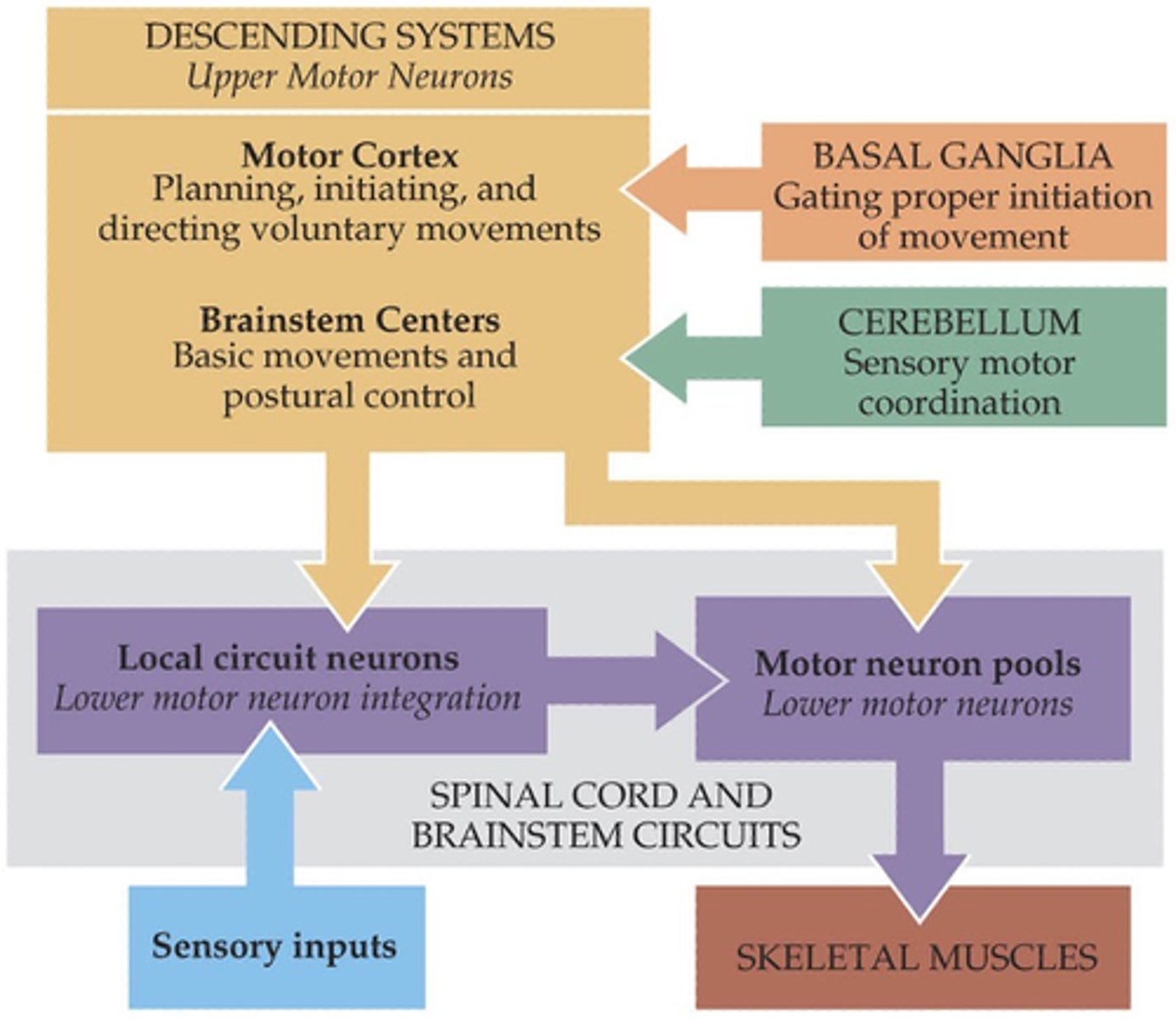
Neurodegenerative
What style of diseases affect both the basal ganglia and cerebellum?
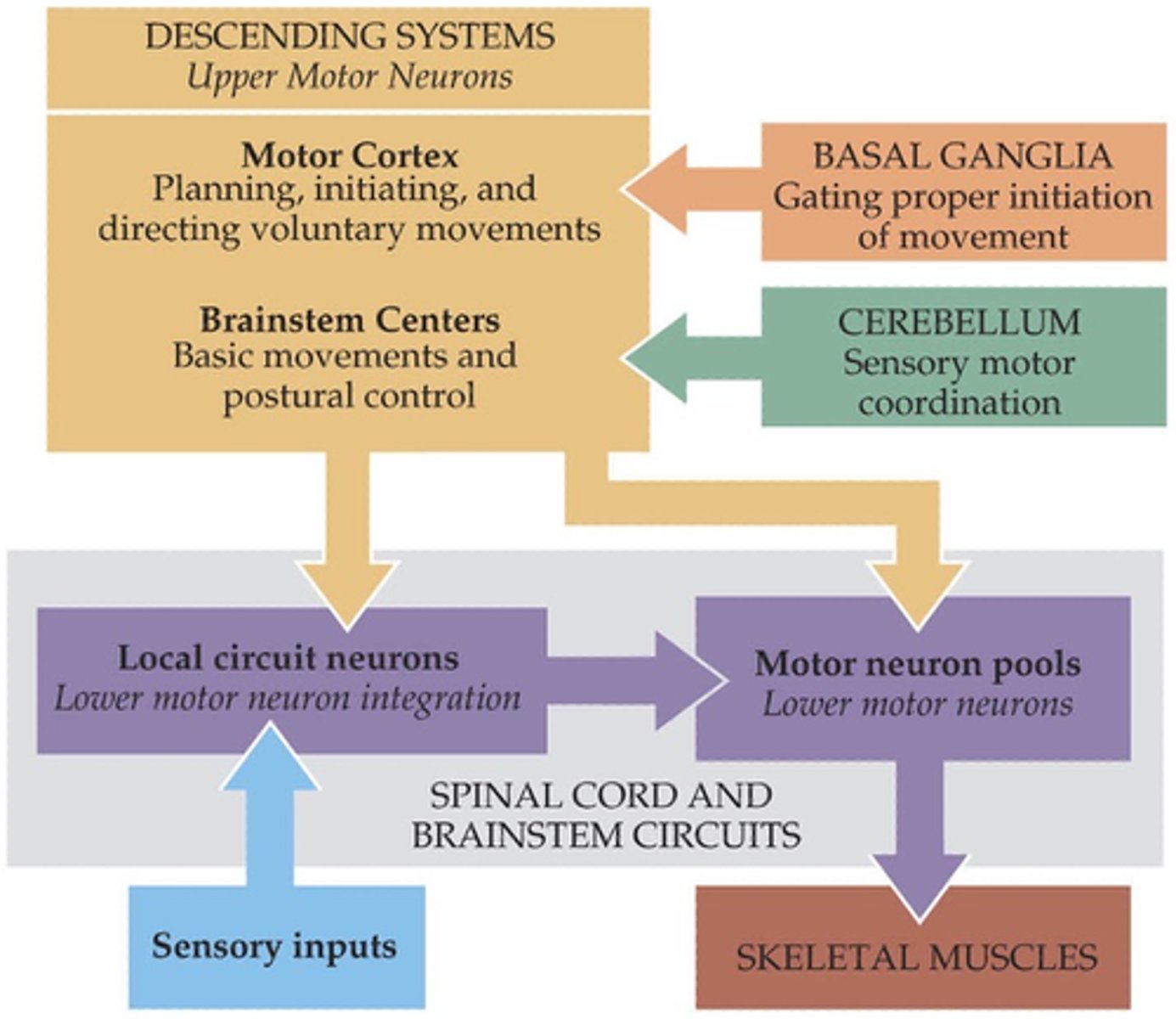
Movement
The basal ganglia plays a role in the initiation of ...?
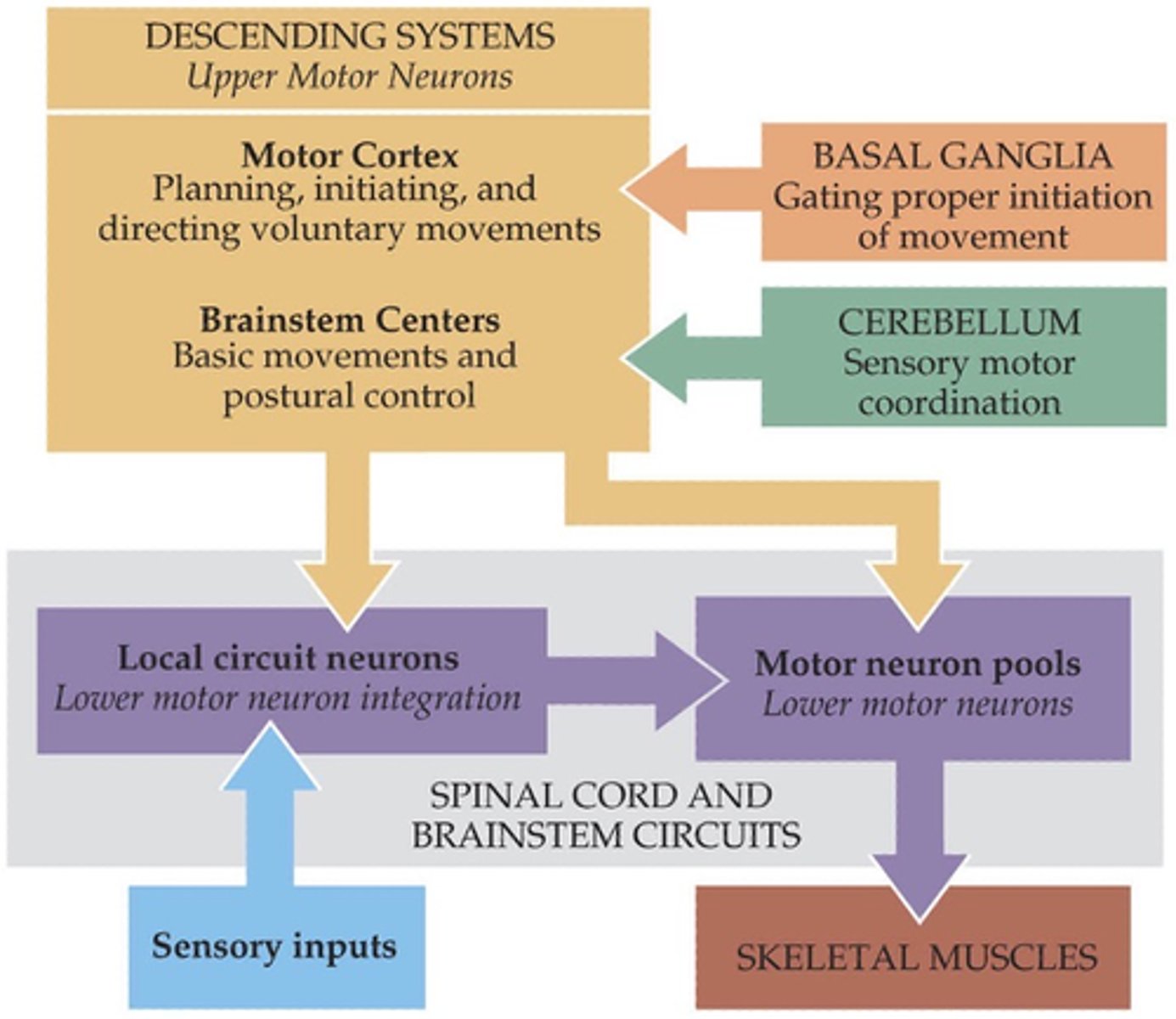
Motor cortex (telencephalon)
Basal ganglia (forebrain)
- Caudate
- Putamen
- Globus Pallidus
- Subthalamic nucleus
Ventral lateral nucleus of thalamus (diencephalon)
Substantia nigra (midbrain)
What are the key components in the initiation of movement?
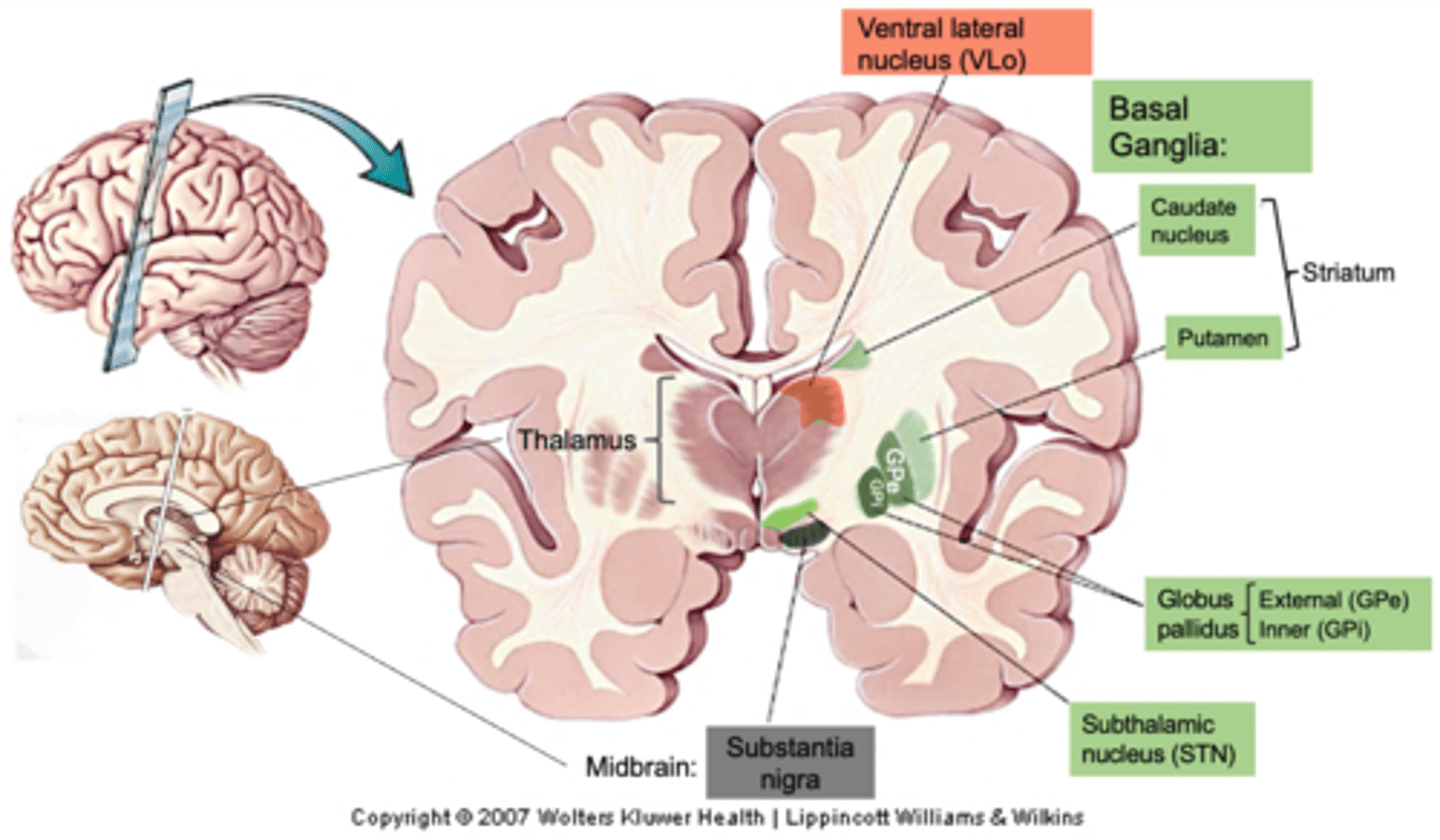
Basal ganglia, Area 6, VLo, motor loop
The motor cortex connects to the ________ _________, which in turn feedback to the premotor area (______ _) via the ventrolateral complex of the thalamus (____) to control the initiation of movement - this is known as the _________ ______
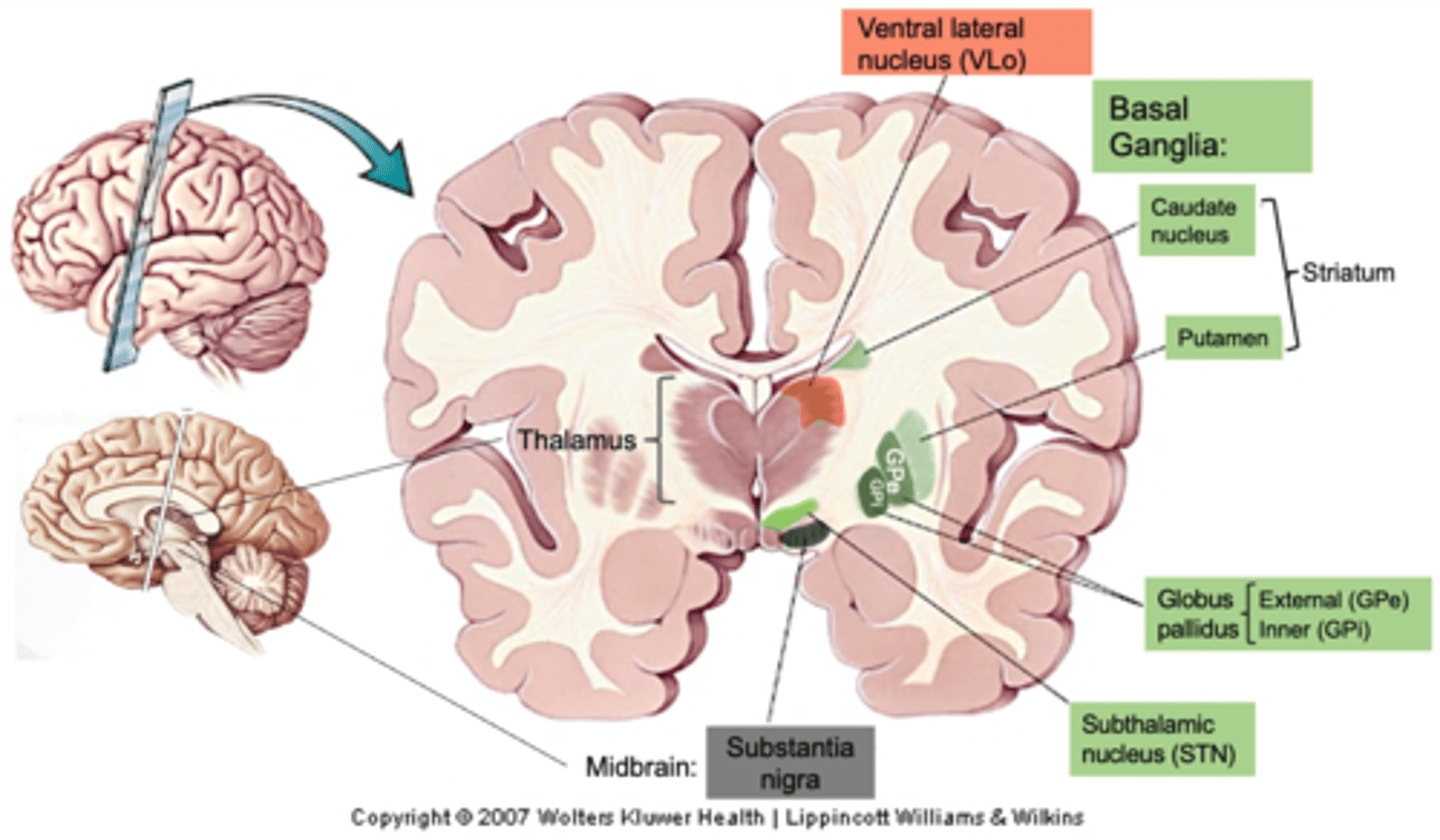
Direct and indirect
The motor loop consists of 2 pathways, what are they?
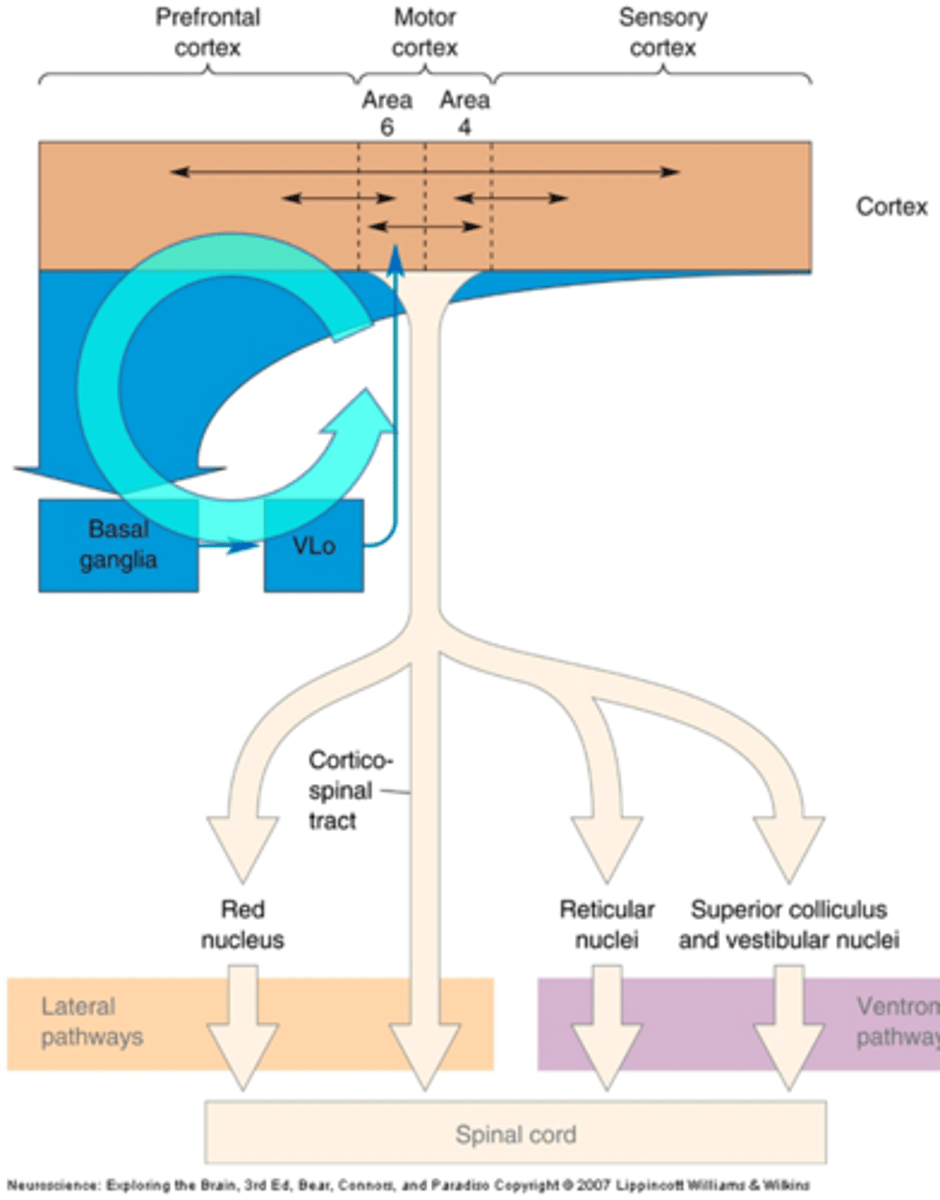
With no initiating cortical input, the Globus pallid us internal segment (GPi) tonically inhibits the VLo
Basal ganglia in the initiation of movement - the direct pathway
Describe (1) in the image
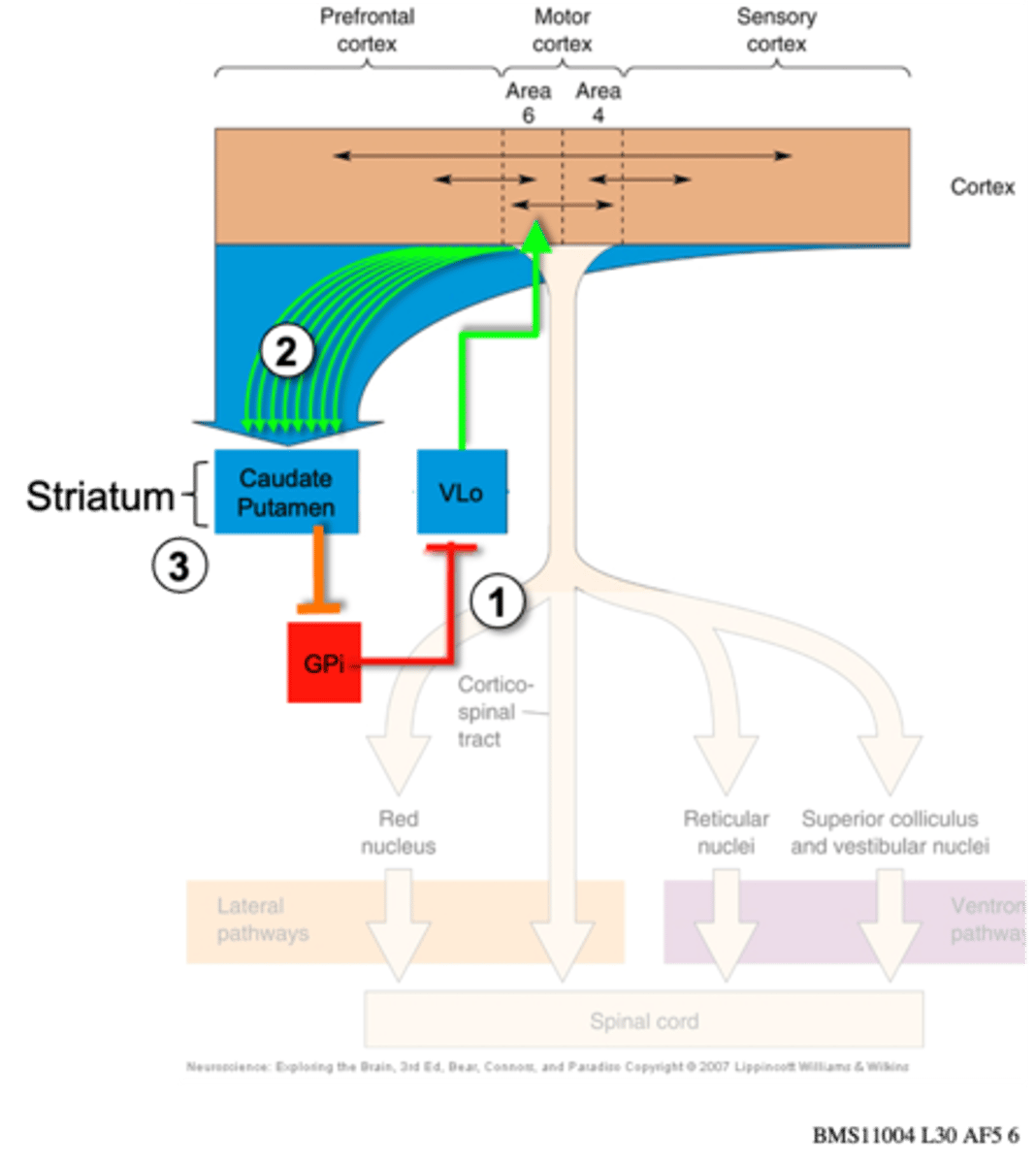
Producing continuous stimulation or inhibition
What is meant by tonically?
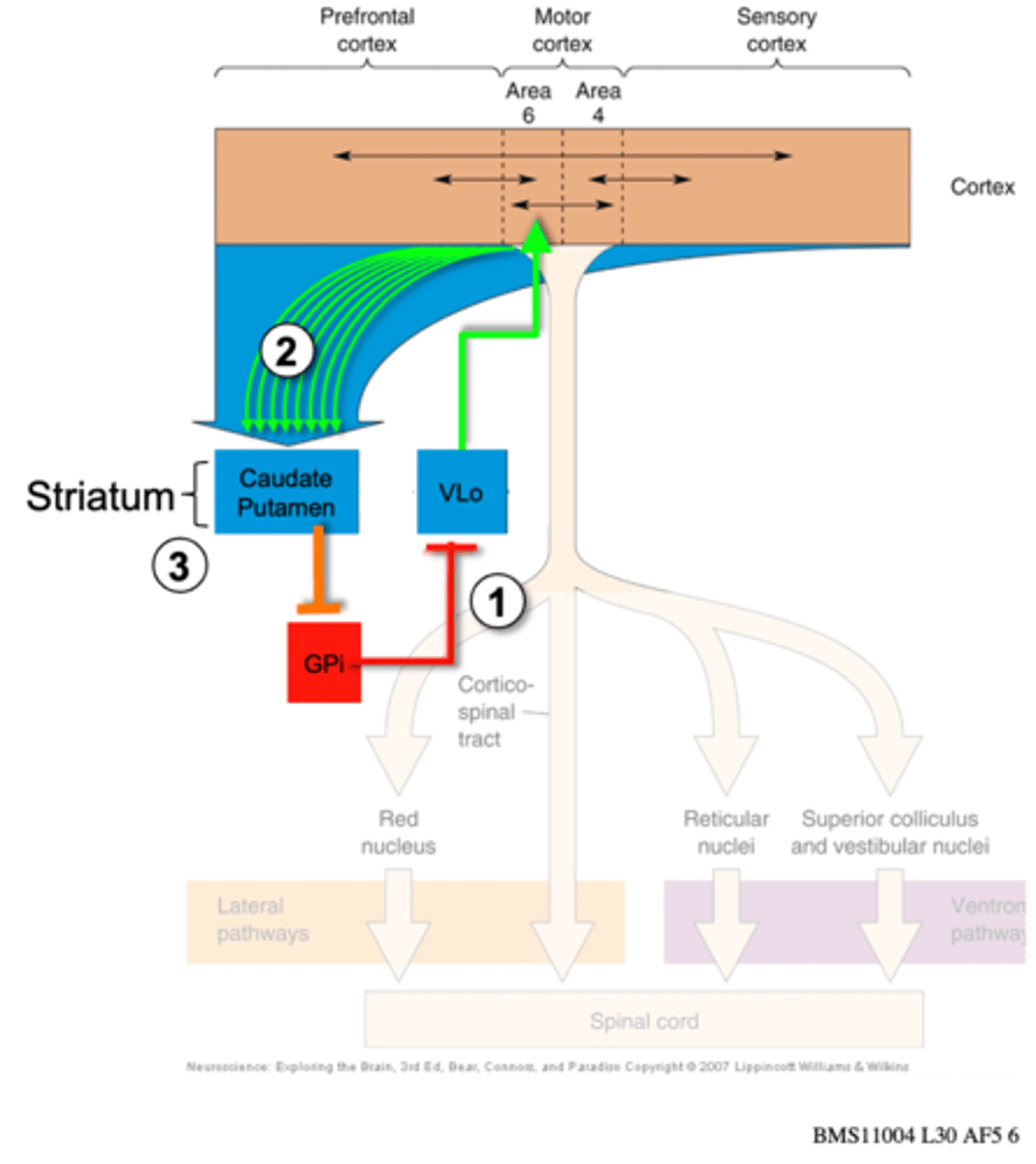
Input from many cortical regions converges on the striatum
Basal ganglia in the initiation of movement - the direct pathway
Describe (2) in the image
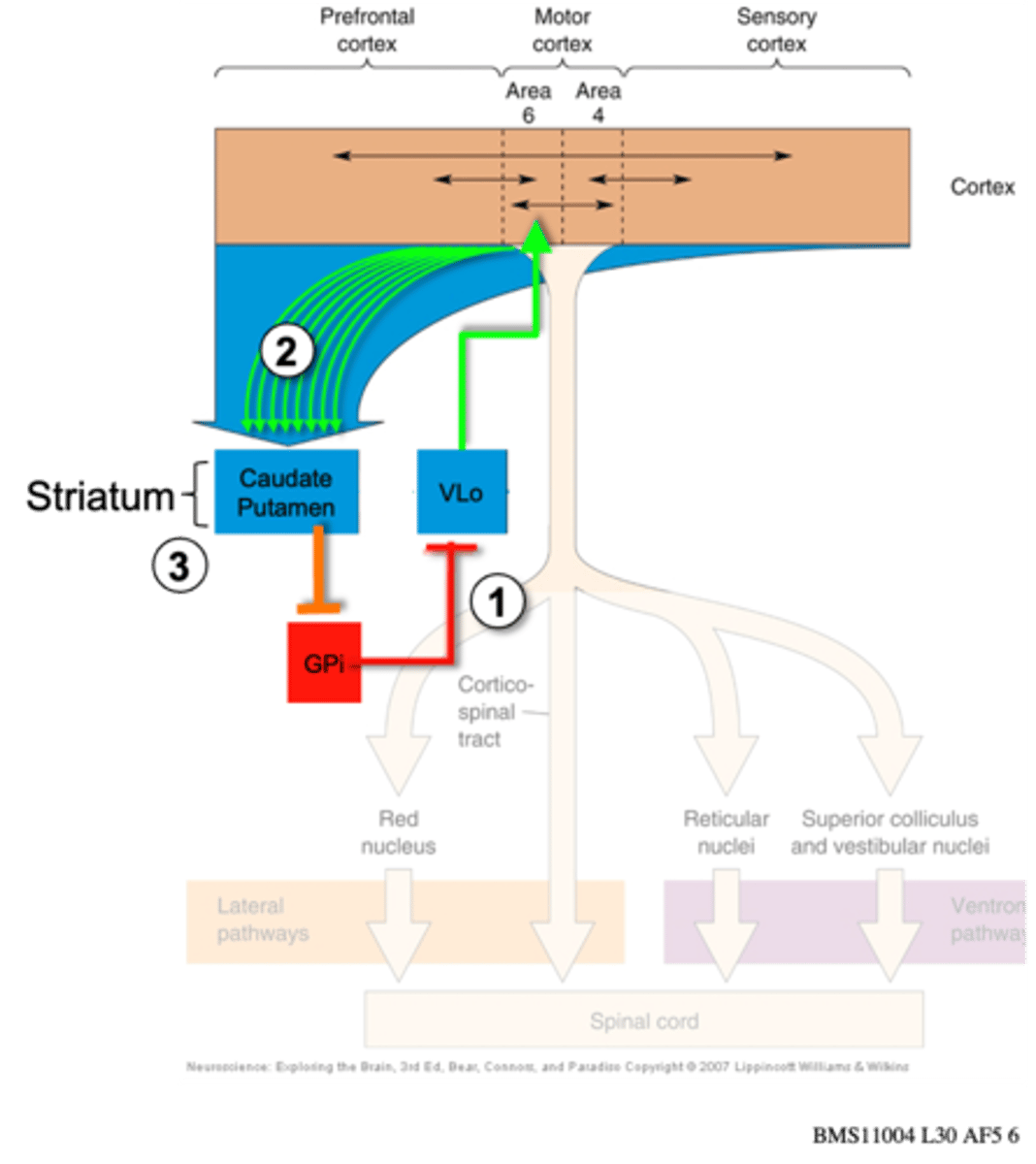
When activated by this input, the striatum inhibits, the inhibitory activity of the GPi, releasing the VLo to activate Area 6 and initiate movement
Basal ganglia in the initiation of movement - the direct pathway
Describe (3) in the image
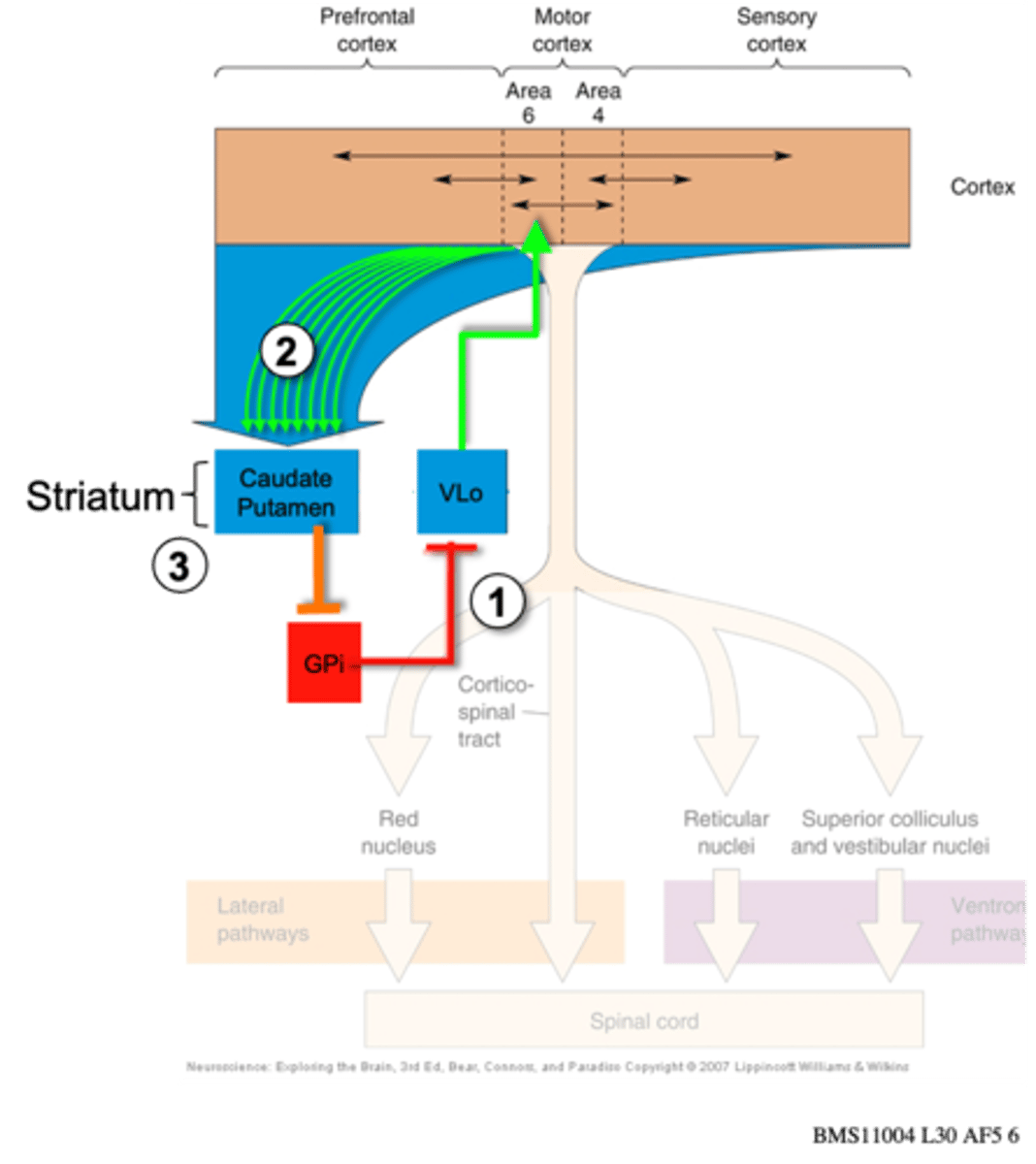
Integration of cortical inputs to trigger a response
Rapidity of response - "engine is running"; inhibition of inhibition releases the "brake"
Why set it up like this?
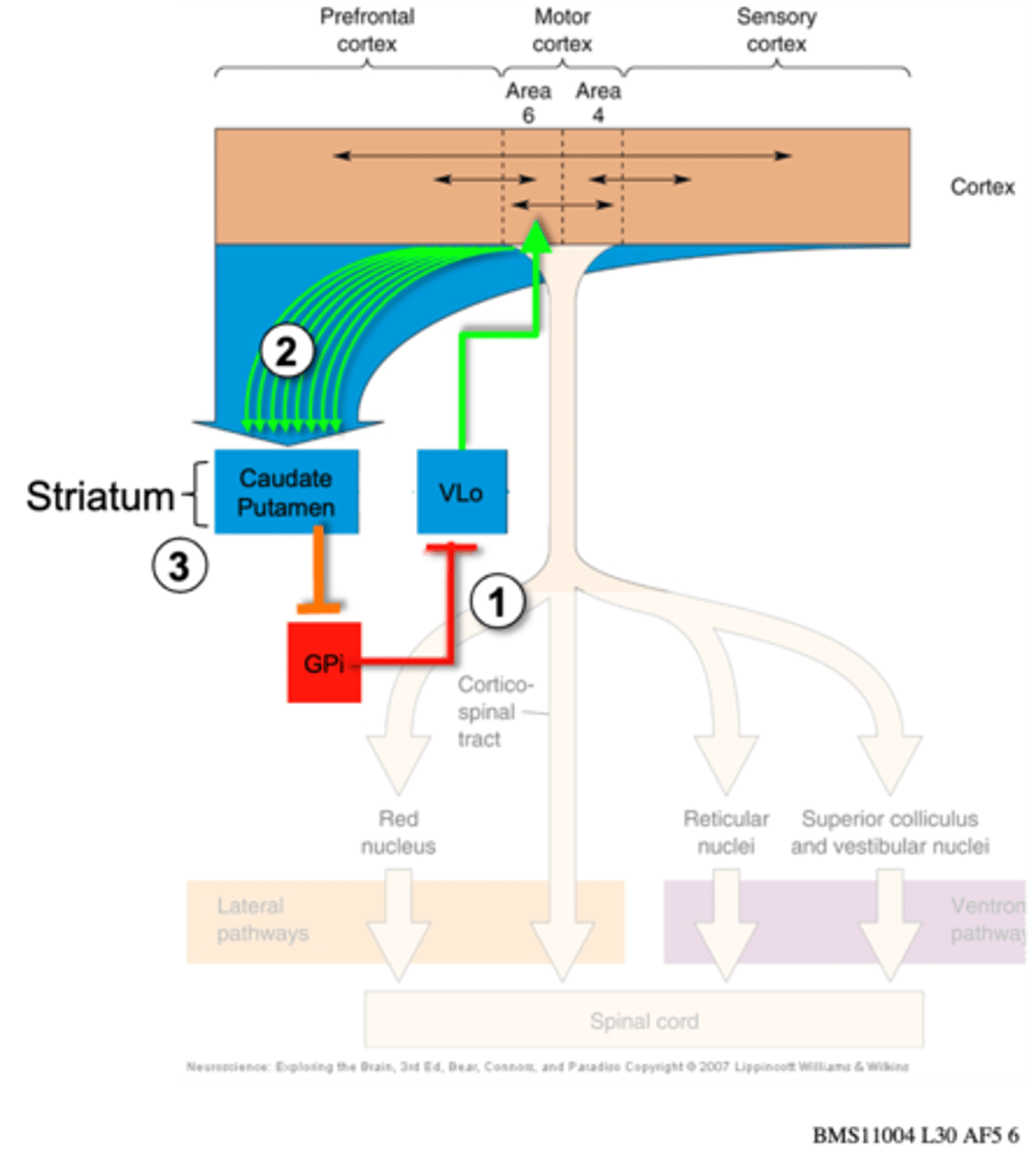
Indirect pathway, substantial nigra, GPe
Basal ganglia - the indirect pathway
The direct pathway is modulated by a complex ___________ __________ which involves the ____________ _______ (SN) and GP external segment (___)
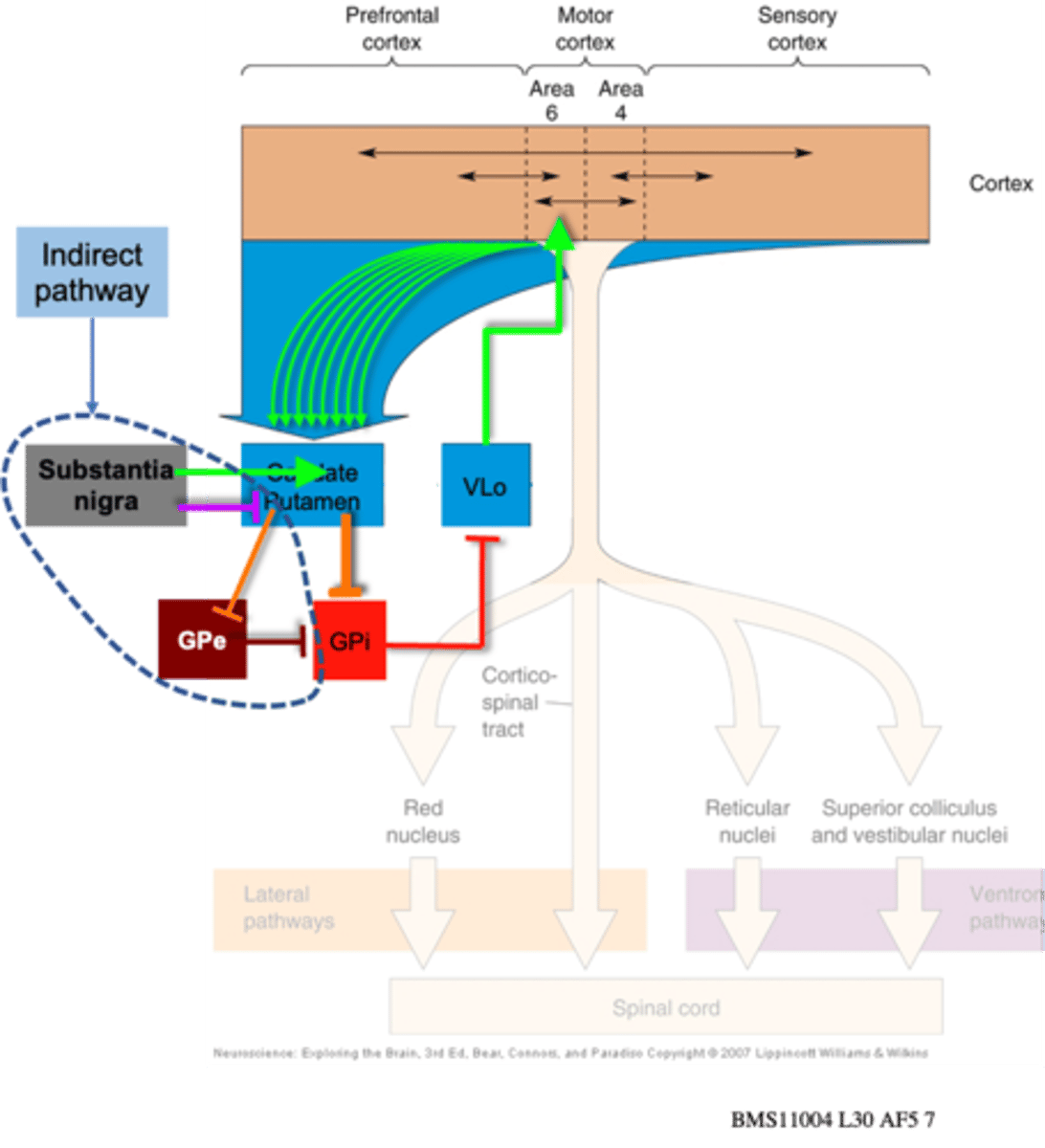
Substantia nigra, activation, direct, indirect, GPe, inhibited, decreases, activation
Basal ganglia - the indirect pathway
The _____________ _______ has a complex role and acts via the striatum (CP) to maintain the balance between inhibition and activation of the VLo
--> Excitatory input from the SN stimulates VLo ___________, by activating the inhibition of the GPi through the _________ pathway --> In the ___________ pathway, inhibition of GPi by _____ is inhibited by the CP and so the VLo is ___________
--> However, inhibitory input from the SN ___________ CP inhibition of the GPe, which then inhibits the GPi allowing __________ of the VLo
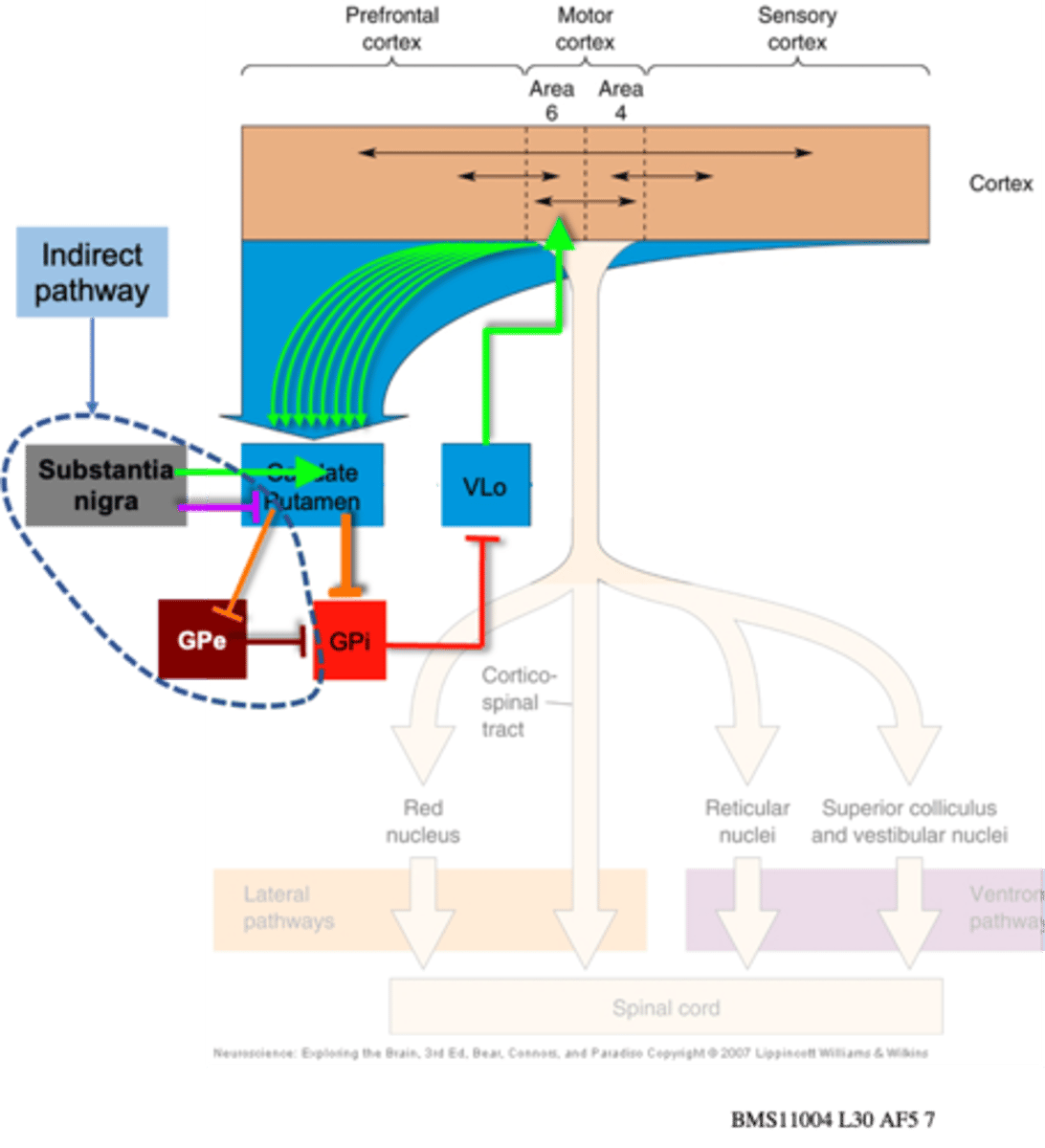
VLo
Basal ganglia - the indirect pathway
So the SN is balancing/tuning the activation of the ______

Parkinson's, Huntington's
Degeneration of neurons in different parts of this circuit leads to ______________ or ______________ disease
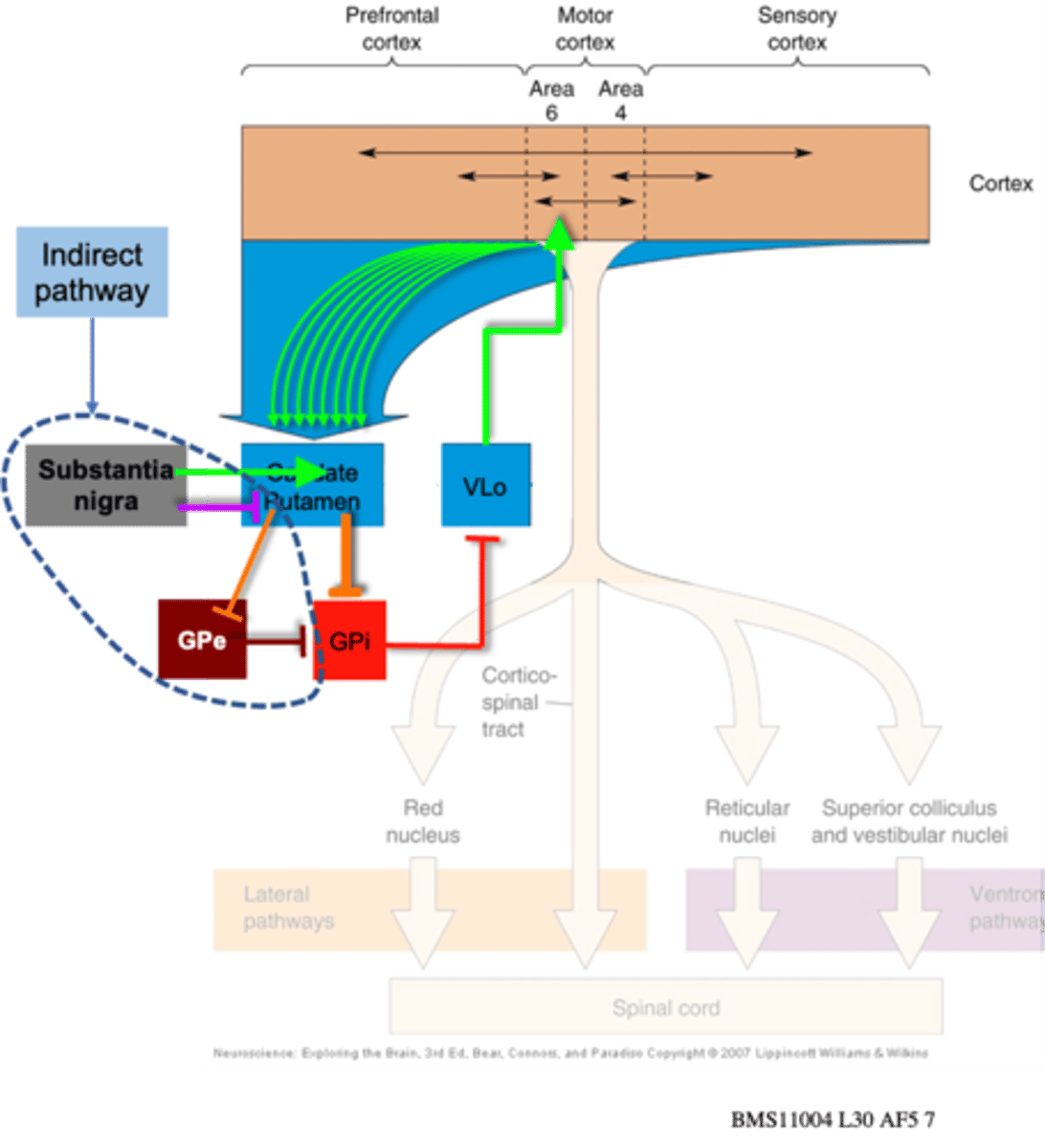
James Parkinson in 1817
Who and when was Parkinson's disease first described?
Essay on the Shaking Palsy
What was the essay James Parkinson wrote in 1817 called?
1, 100, 85, 90, 10, 15
Parkinson's is the second most common degenerative disorder (_:___ people over the age of 60)
Sporadic cases (__-__%)
Familial cases (__-__%) caused by genetic mutations
Hypokinesia - paucity/insufficiency of movement
Bradykinesia - very slow movements
Akinesia - no movements
Increased muscle tone - rigidity
Resting tremor - at 4-5Hz - 'pill rolling'
Shuffling gait and flexed posture, impaired balance
Mask-like expression
What are the motor symptoms of Parkinson's disease?
Mood disorders, loss of sense of smell
What are the non-motor symptoms of Parkinson's?
Loss of Dopamine (DA)
What is Parkinson's caused by?
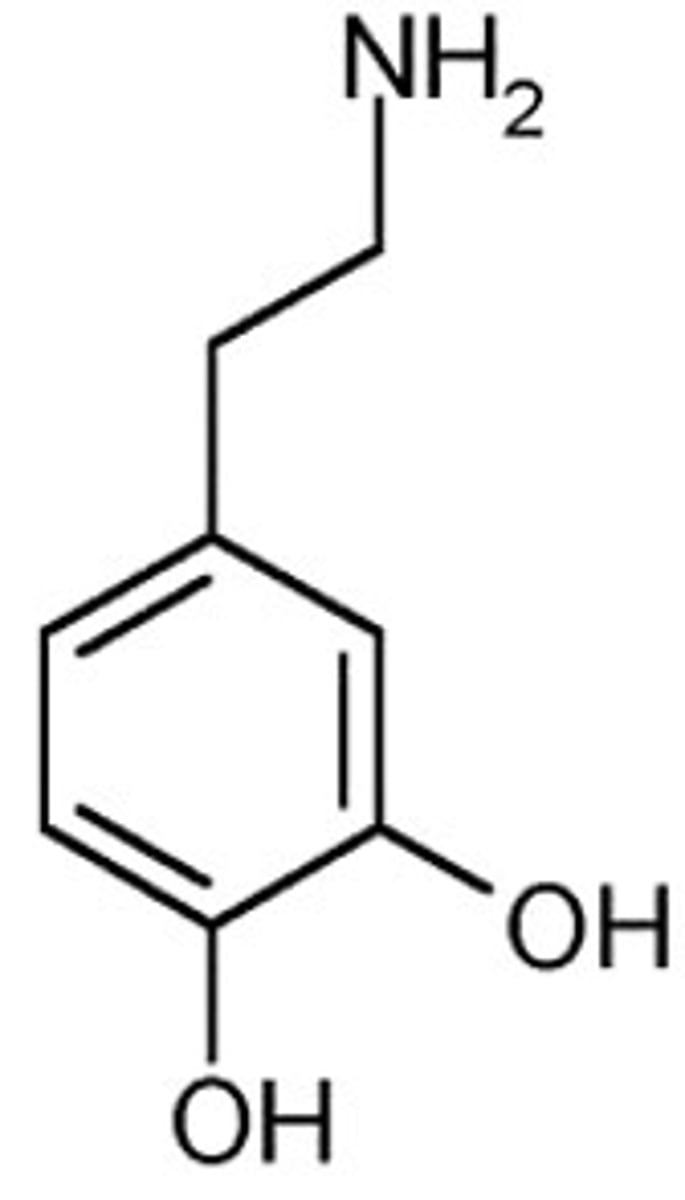
A brain disorder resulting from deficiency of a single neurotransmitter
Parkinson's is the first example of what?
Basal ganglia, substantia nigra
80% of the brain's dopamine is found in the ________ ________, specifically the _____________ ______ (SN)
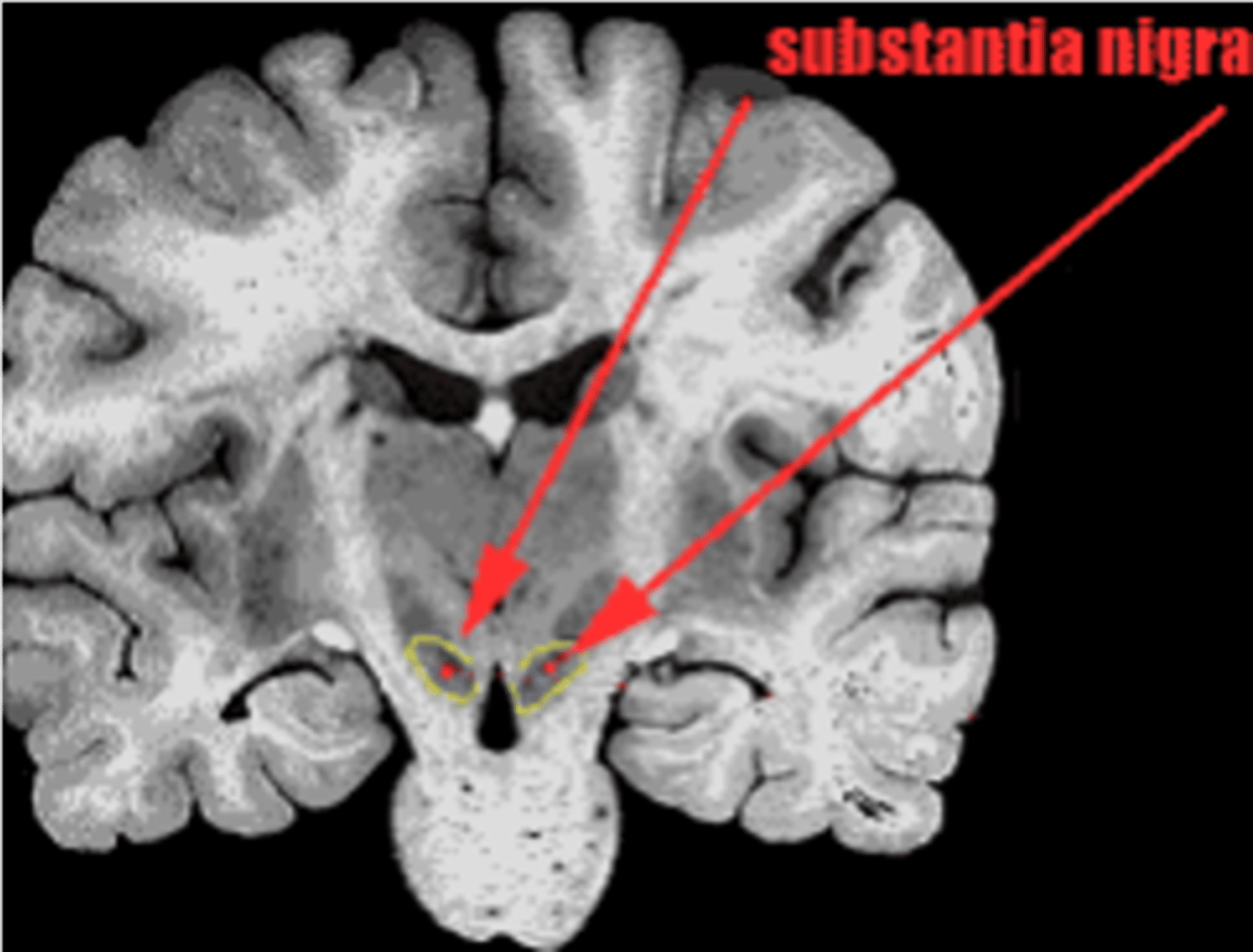
Loss of dopaminergic (DA-ergic) neurons in the substantial nigra
Loss of dopamine in PD patients is due to what?
Loss of dopamine (DA-erguc)
Loss of dopaminergic (DA-ergic) neurons in the substantial nigra
Loss of dopamine in PD patients is due to what?

That intravenous L-dihydroxyphenylalanine (L-DOPA - a dopamine precursor) provided a dramatic though brief reversal of symptoms in PD patients
What did Oleh Horyenkiewicz (early 1960s) find out?
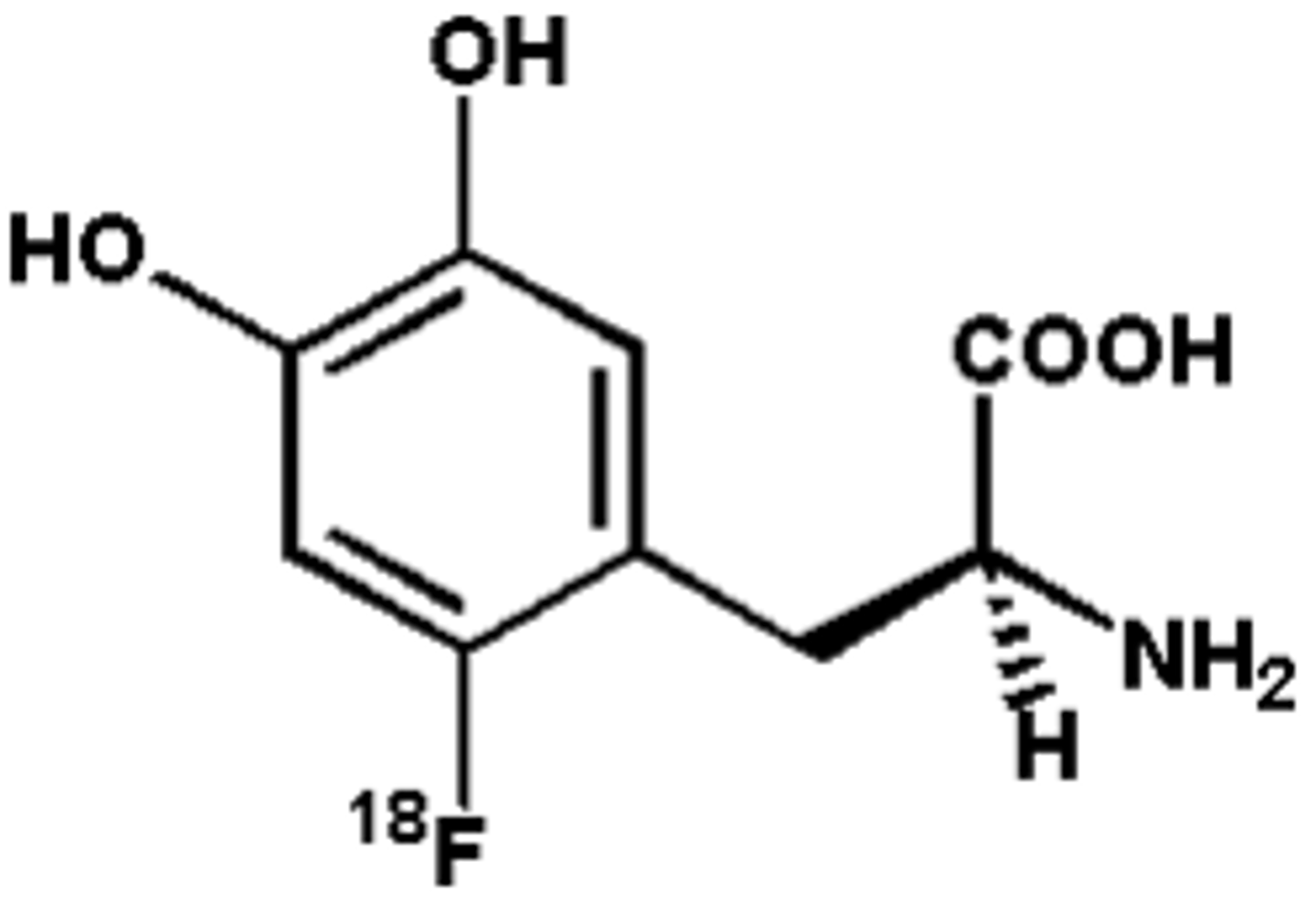
That gradual increases in oral L-DOPA provided significanct and longer benefits
What did Cotzias show later on?
5
Beneficial effects of L-DOPA only last for around how many years?
By boosting capacity of surviving DA-ergic neurons in substantial nigra (SN) to make dopamine (DA)
Does not stop the degeneration of SN neurons
Eventually there are insufficient SN neurons left to make DA
How does L-DOPA work?
Increase in motor response fluctuations and drug related dyskinesias
What are the side effects of L-DOPA?
Increased activity of the indirect pathway and decreased activity of the direct pathway
Reduced dopaminergic input from substantial nigra to striatum leads to both ...?
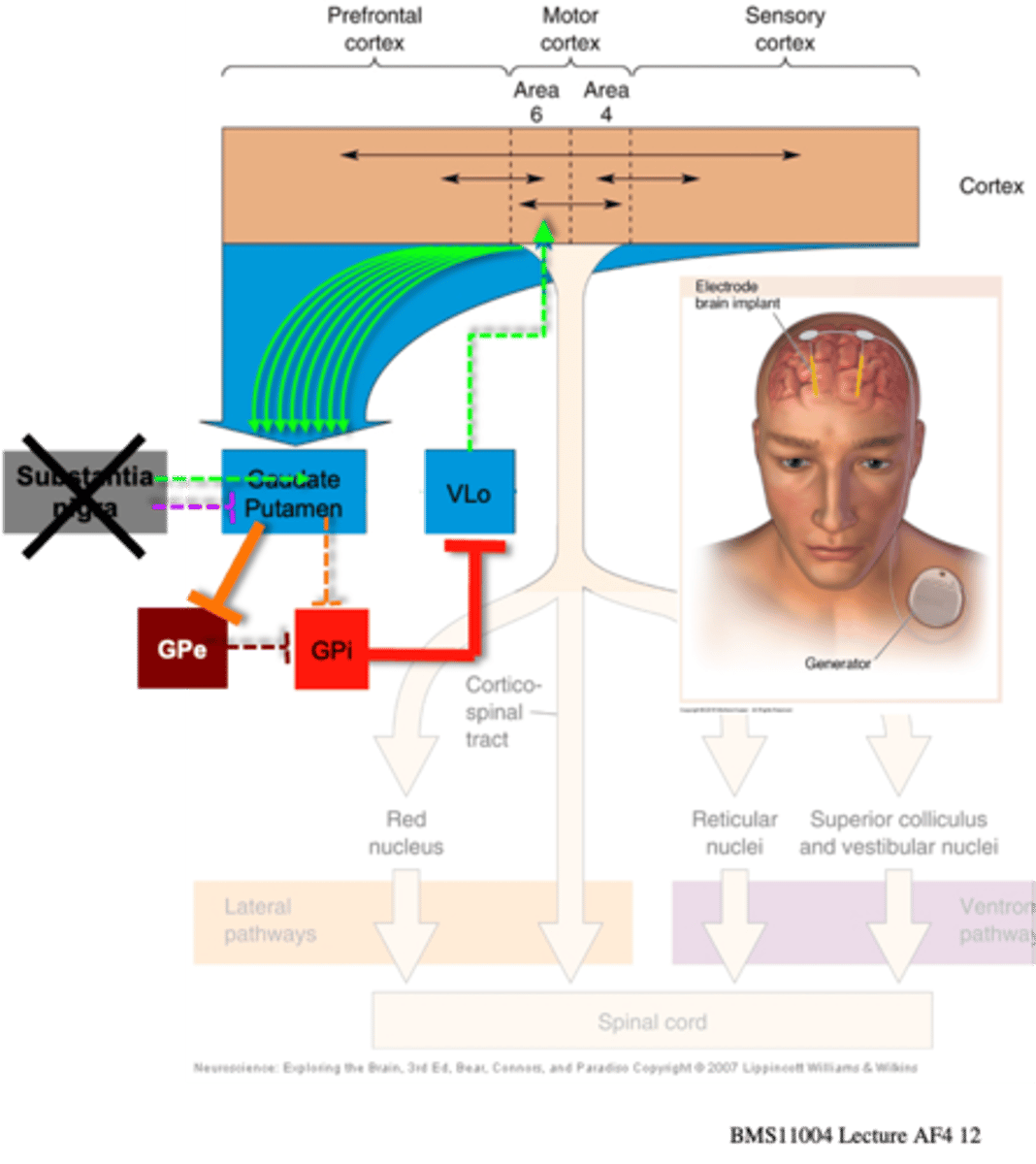
Less inhibition of the GPi and so its inhibitory activity is increased
This leads to decreased activity of the VLo and so less motor cortex activation
--> Hypokinesis - reduced movement
(L-DOPA reverses this effect, but only as long as some DA-ergic neurons survive)
What does it mean if there's an increased activity of the indirect pathway and decreased activity of the direct pathway?

GPi, Parkinsonian
In severe PD cases, surgical removal of the ____ ('pallidotomy') can be effective in reversing the _______________ effects
Deep brain stimulation
What has been used recently to inhibit GPi hyperactivity?
3, 7
Huntington's disease is rare, hereditary, progressive, fatal - _-_ people per 100,000 with European ancestry, less in other ethnic groups
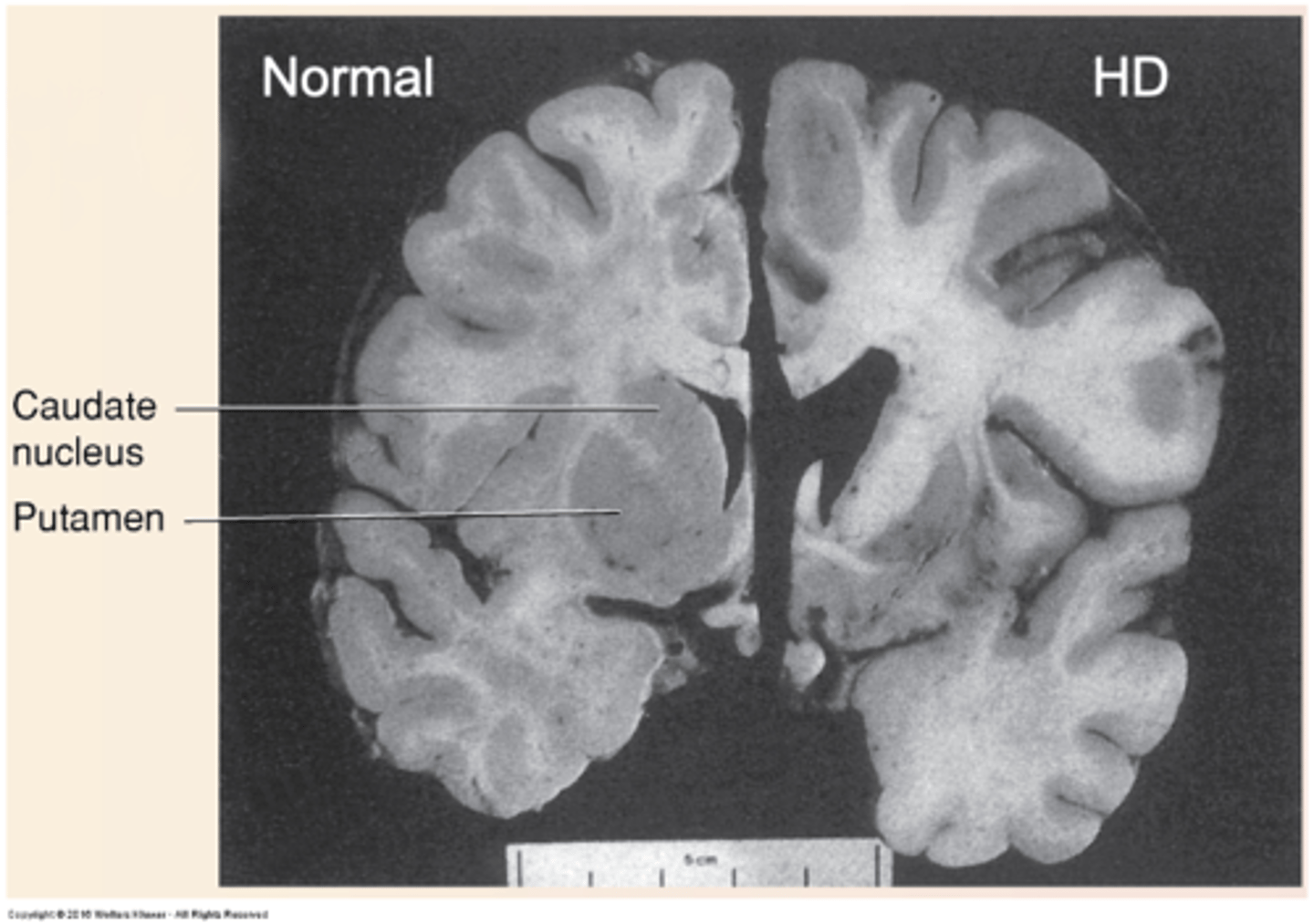
George Huntington (1851-1916)
Who discovered Huntington's disease?
Hyperkinesia or dyskinesia, 'chorea' (involuntary jerking or twitching movements)
What are the early symptoms of Huntington's disease?
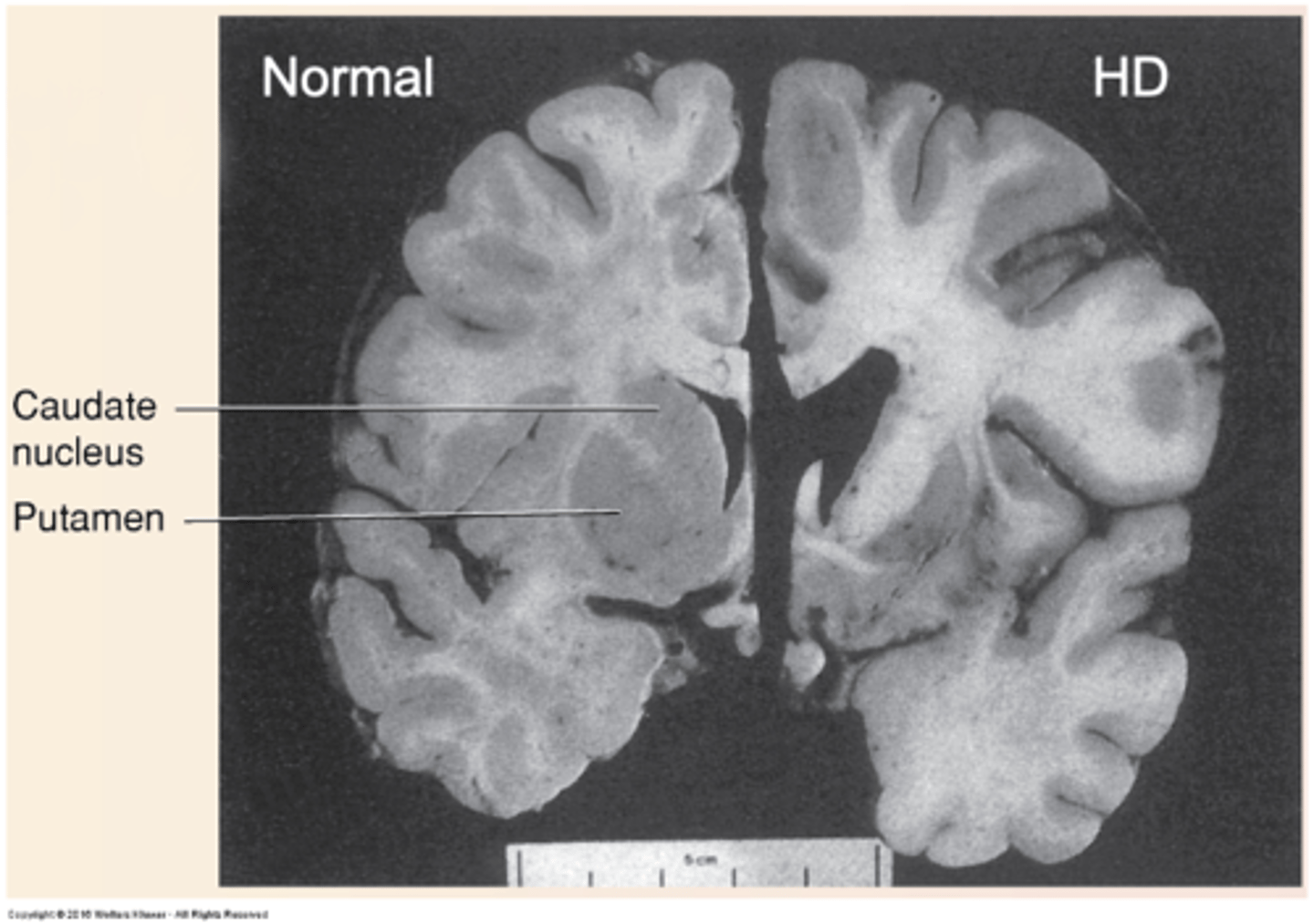
Akinesia and dystonia (muscle spasms), dementia, personality disorder (psychosis)
What are the late symptoms of Huntington's disease?
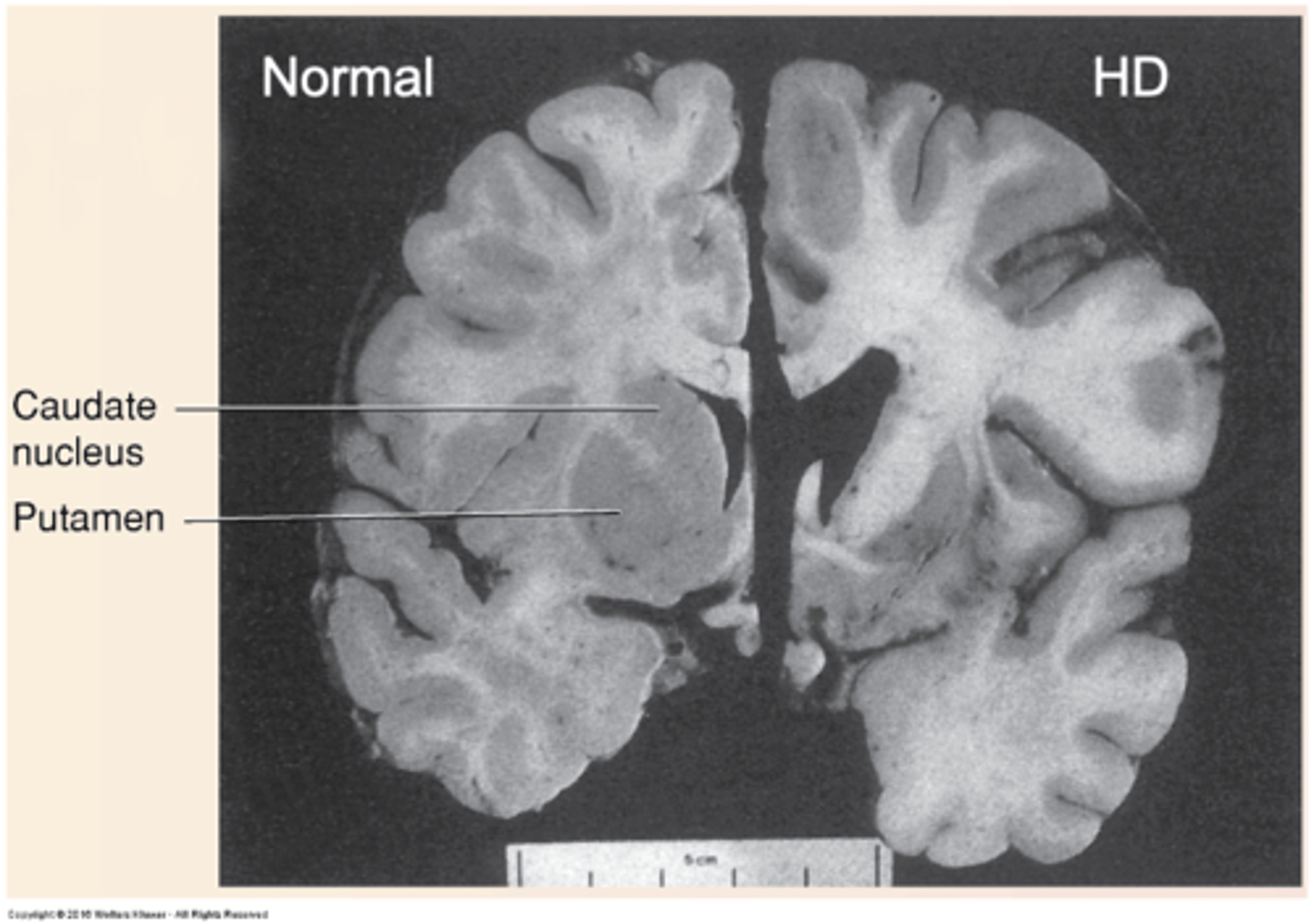
Autosomal dominant genetic disease resulting in neuronal degeneration:
--> Initially in the indirect pathway components of the striatum
--> Subsequently in the direct pathway components and in the GPe
What is the cause of Huntington's disease?
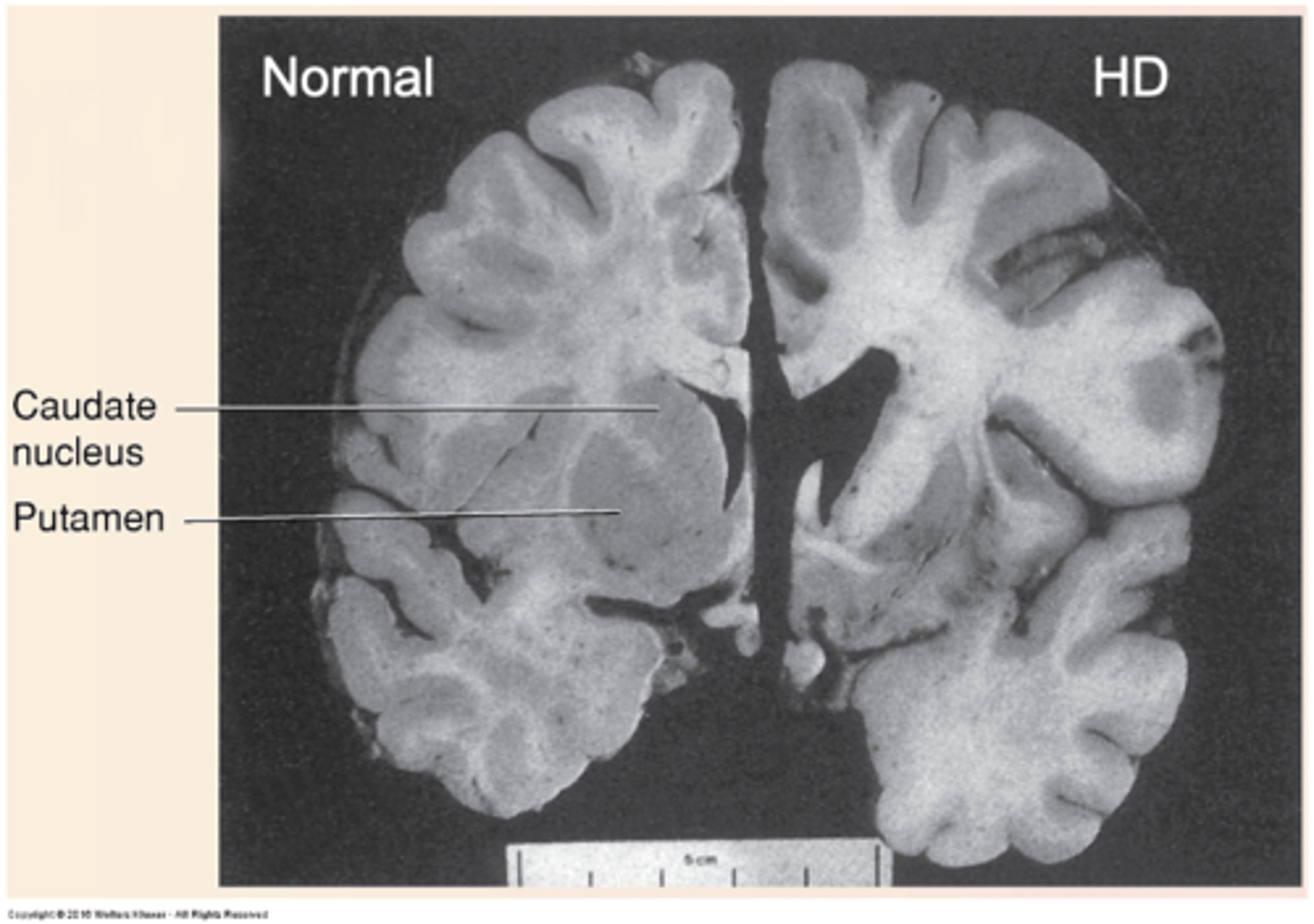
Degeneration in the striatum reduces (X) the indirect path inputs to the GPe
This increases the inhibition of the GPi with the result that the VLo is dis-inhibited and there is inappropriate initiation of movement
--> Hyperkinesis, chorea
What happens early on in Huntington's in the basal ganglia?
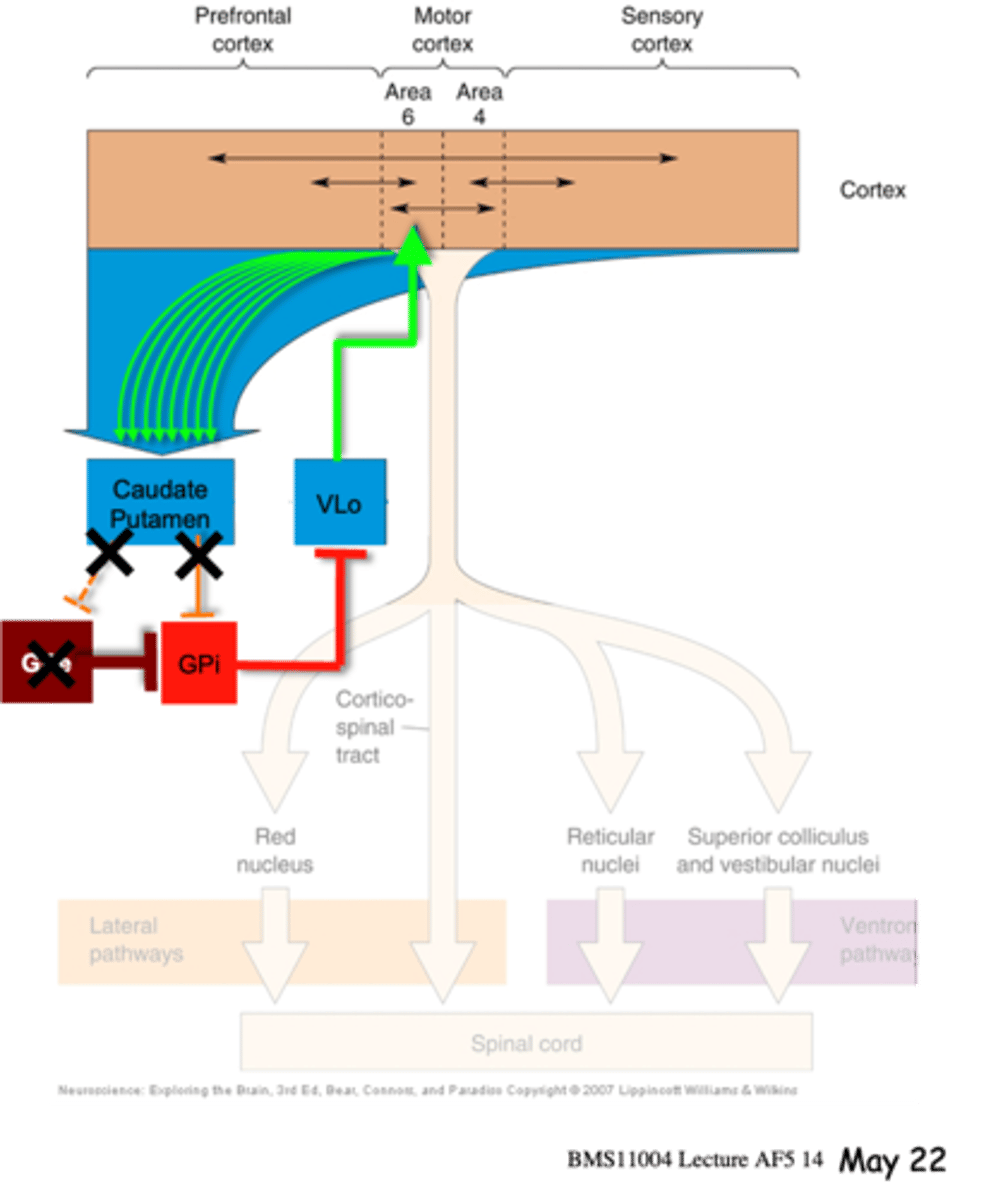
The striatal direct path and GPe neurons also degenerate, releasing the GPi to over-inhibit the VLo
--> Akinesia
What happens later on in Huntington's in the basal ganglia?
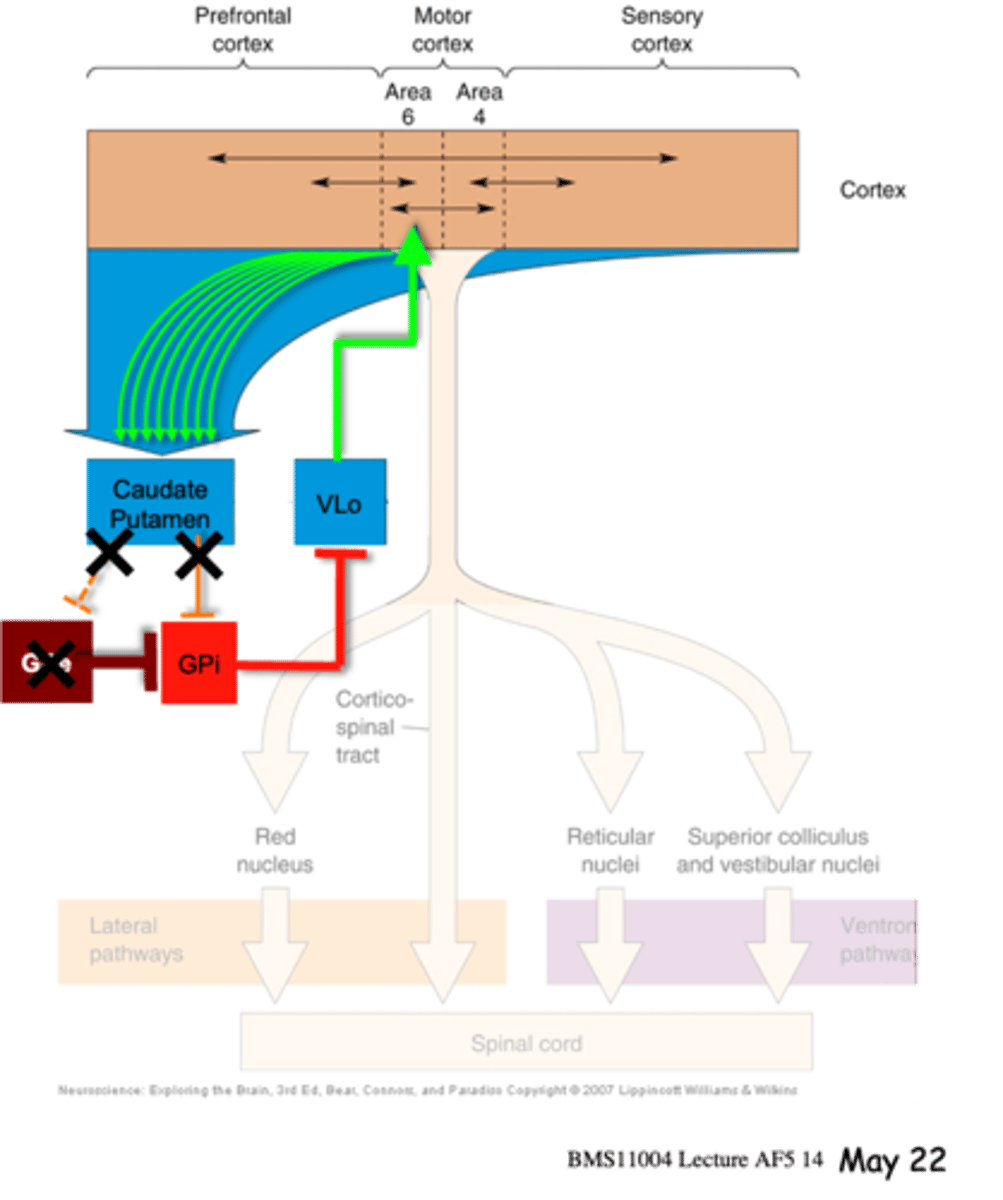
Caudate, putamen, globus pallidus
The basal ganglia include the ________, ___________ and __________ __________ and are regulated by the substantial nigra
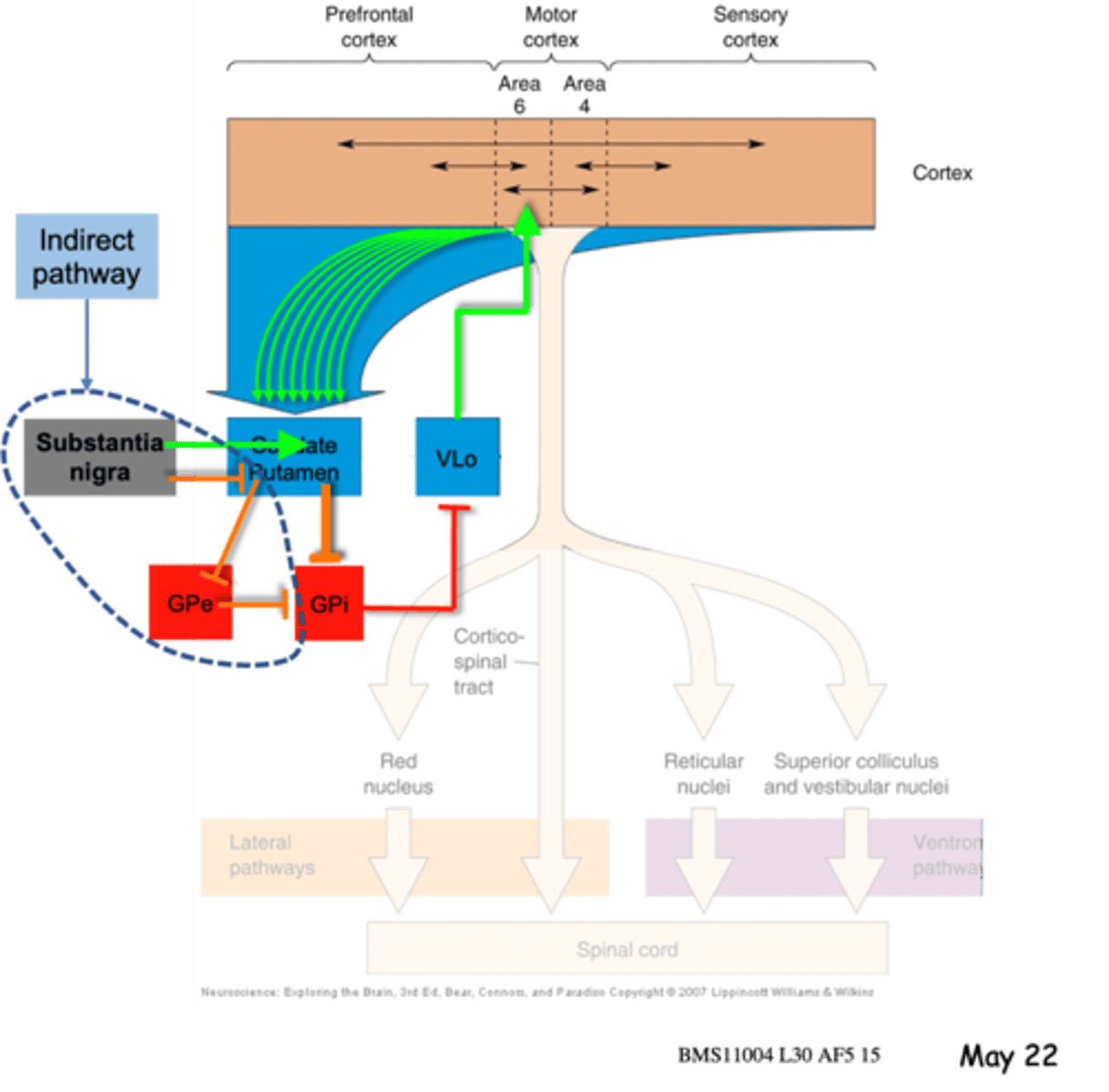
Striatum, hyperkinesis, akinesis
HD is due to degeneration of the __________ and leads initially to ______________ and then to _________
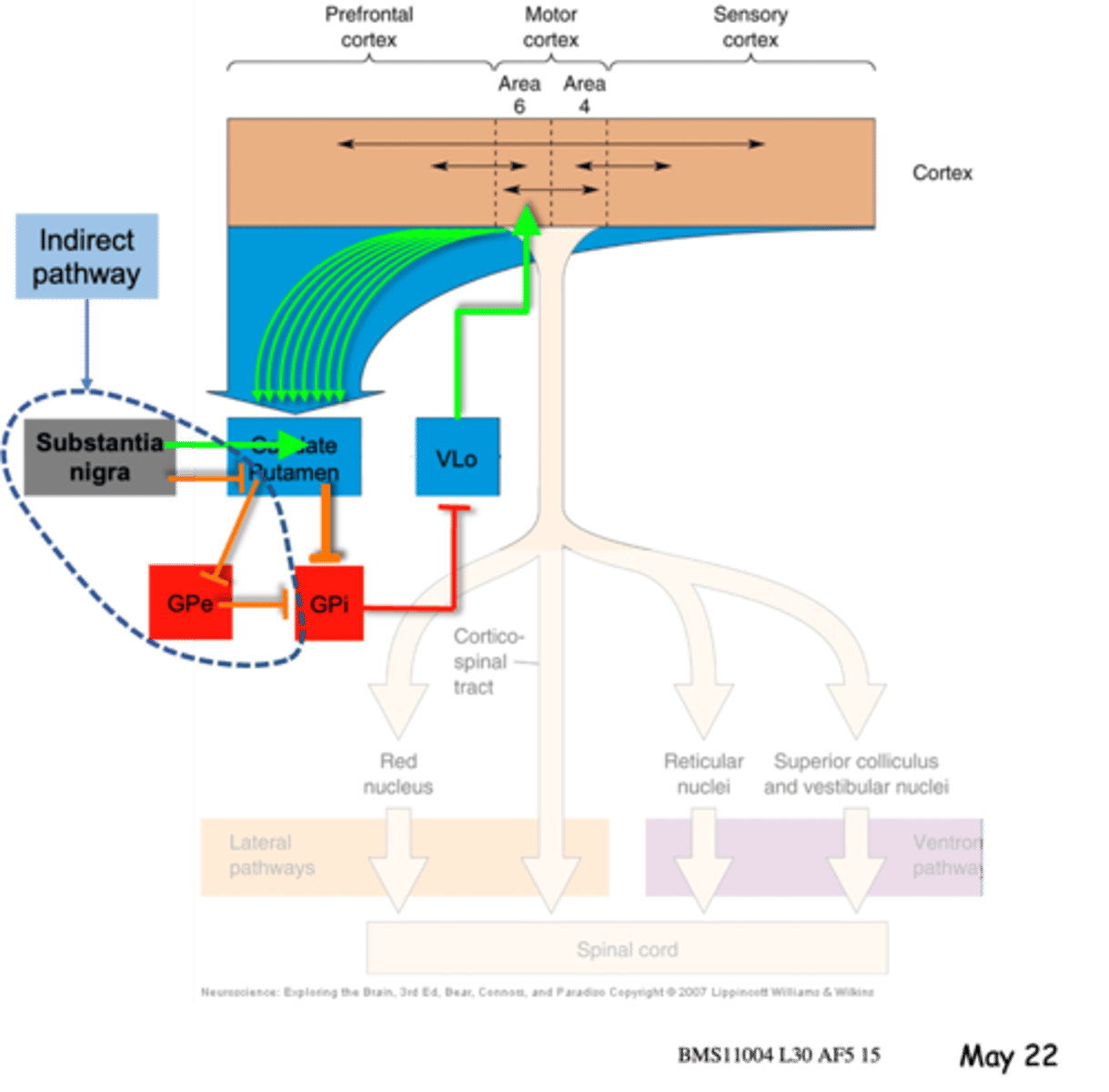
Substantia nigra, hypokinesis
PD is due to degeneration of the ______________ _______ and leads to _____________
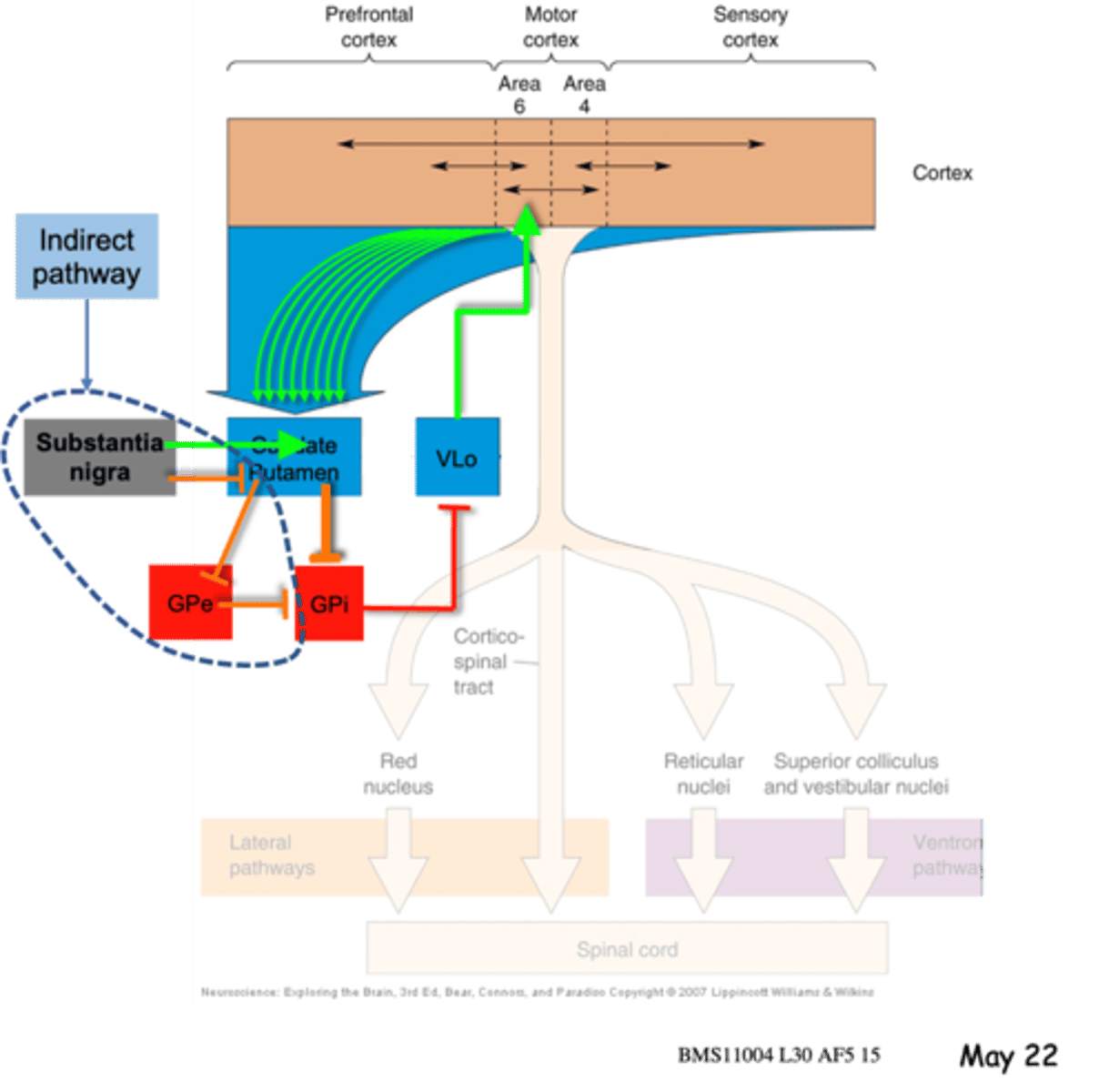
Inherited, genetic
Both PD and HD have an ______________, _________ element
Sporadic/idiopathic
Most cases of PD are __________/___________ but the disease is common (1% in >60s), only 10-15% are inherited
Specific to an individual, cause unknown
What is idiopathic?
Sporadic, 0.005
HD is rarely __________ (therefore mainly inherited) but rare (_____%)
If you have the mutation you are very likely to get the disease
Mutations in multiple genes 'predispose' you to getting PD: some are rare but with high 'penetrance' (e.g. SNCA) others are common but have low penetrance (e.g. GBA1) - what is meant by high penetrance?
HTT
Only mutations in _____ (encoding 'Huntingtin' protein) cause HD, but if you have the specific mutation you are certain to get the disease at some point (onset varies)
Protein degredation, mitochondrial function
PD genes encode proteins involved either in _________ ______________ pathways (e.g. Parkin, SNCA; hence Lewy body protein aggregates) or in _______________ __________ (e.g. PINK1, DJ-1)
Intracellular transport, poly-glutamine
The function of HTT protein remains unclear but its feature suggest it is involved in _______________ _________ - mutant HTT protein contains extended stretches of ______-____________ (polyQ) which contributes to aggregation of protein in 'inclusion bodies' in affected neurons
Funnel, filter
The basal ganglia act as a kind of. _________, to collect information from the prefrontal and motor cortices, and then as a _______ to decide which information to act upon, balancing the different inputs
5, 7
There is substantial input from many cortical areas, notably Areas _ and _, areas thought to be involved in perceptions of the body in space and time

That the 'decision to act' integrates sensory information about the body in the environment with planning information (Area 6 and Prefrontal) in course of initiating movement
What does the substantial input from many cortical areas suggest?
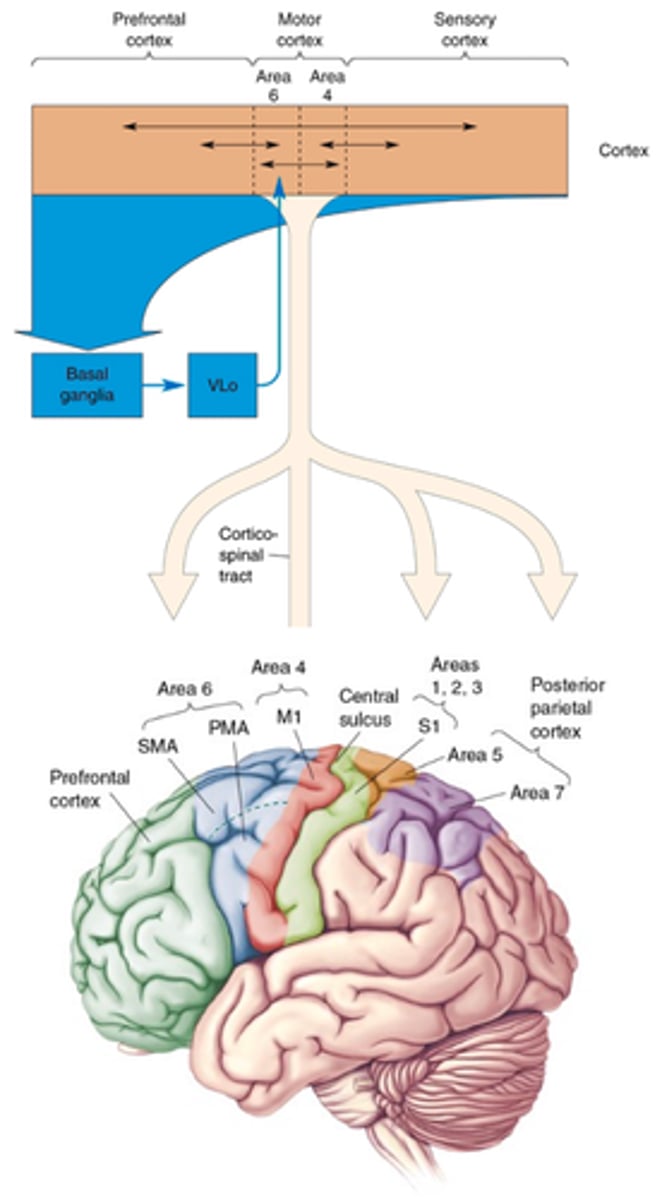
Upper motor neurons - no direct connections to spinal cord
What does the cerebellum modulate?
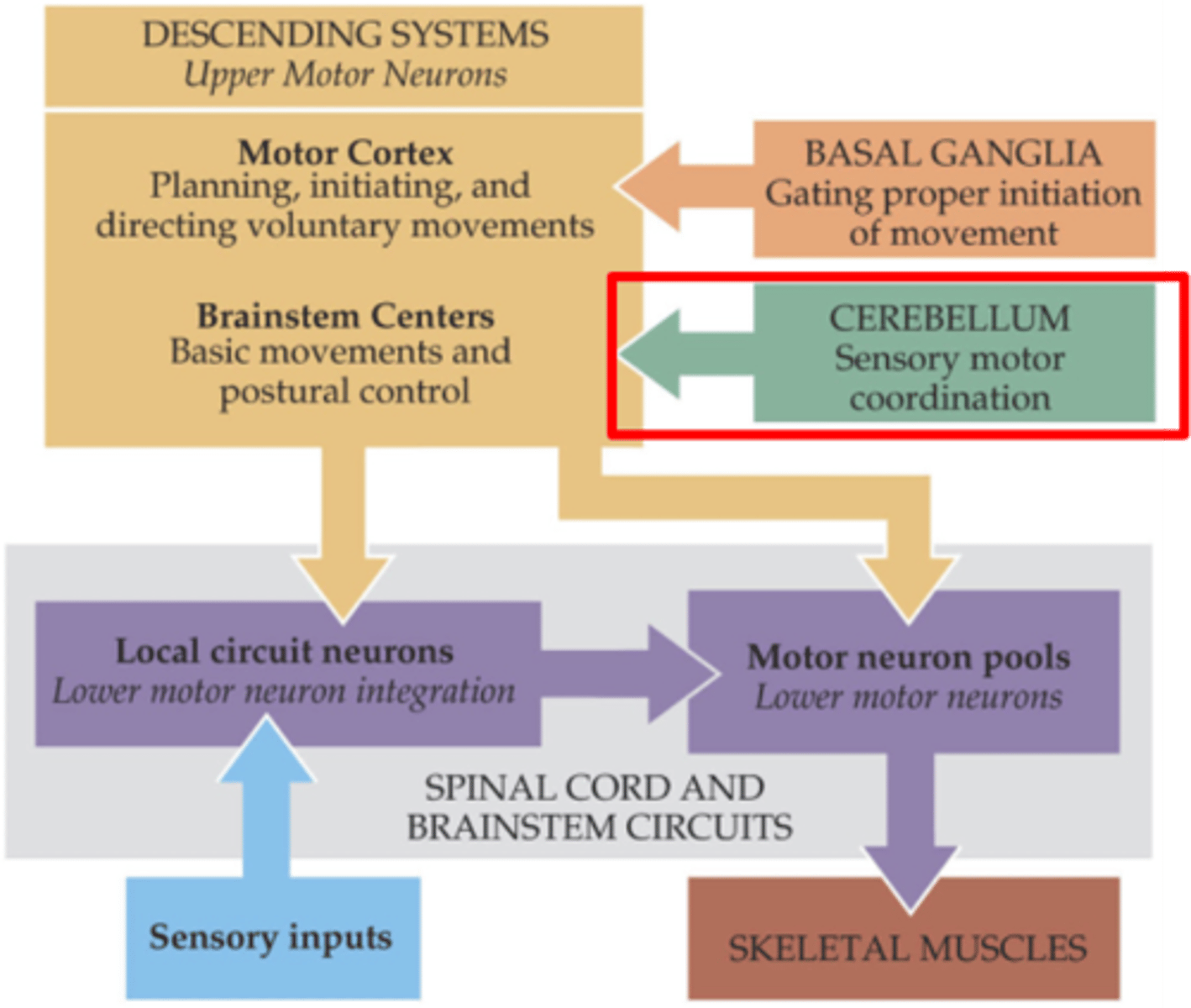
Learned execution of planned, voluntary, multijoint movements
What is the cerebellum required for?
Direction, timing, force, predictions, past experiences, motor learning
In ball throwing (ballistics):
Cerebellum appears to instruct motor cortex with respect to __________, _________ and _______ of movement
This is based on _____________ of outcomes (movements are usually too fast for fed back sensory information to be of immediate use)
Predictions are based on _____ ______________ of movements
Cerebellum also compares what is intended with what actually happens - ________ ____________
Cortex, corticopontocerebellar, sensory
The cerebellum receives massive input from many areas of the _________, ___________________ projection, and ___________ information from the spinal cord and vestibular system
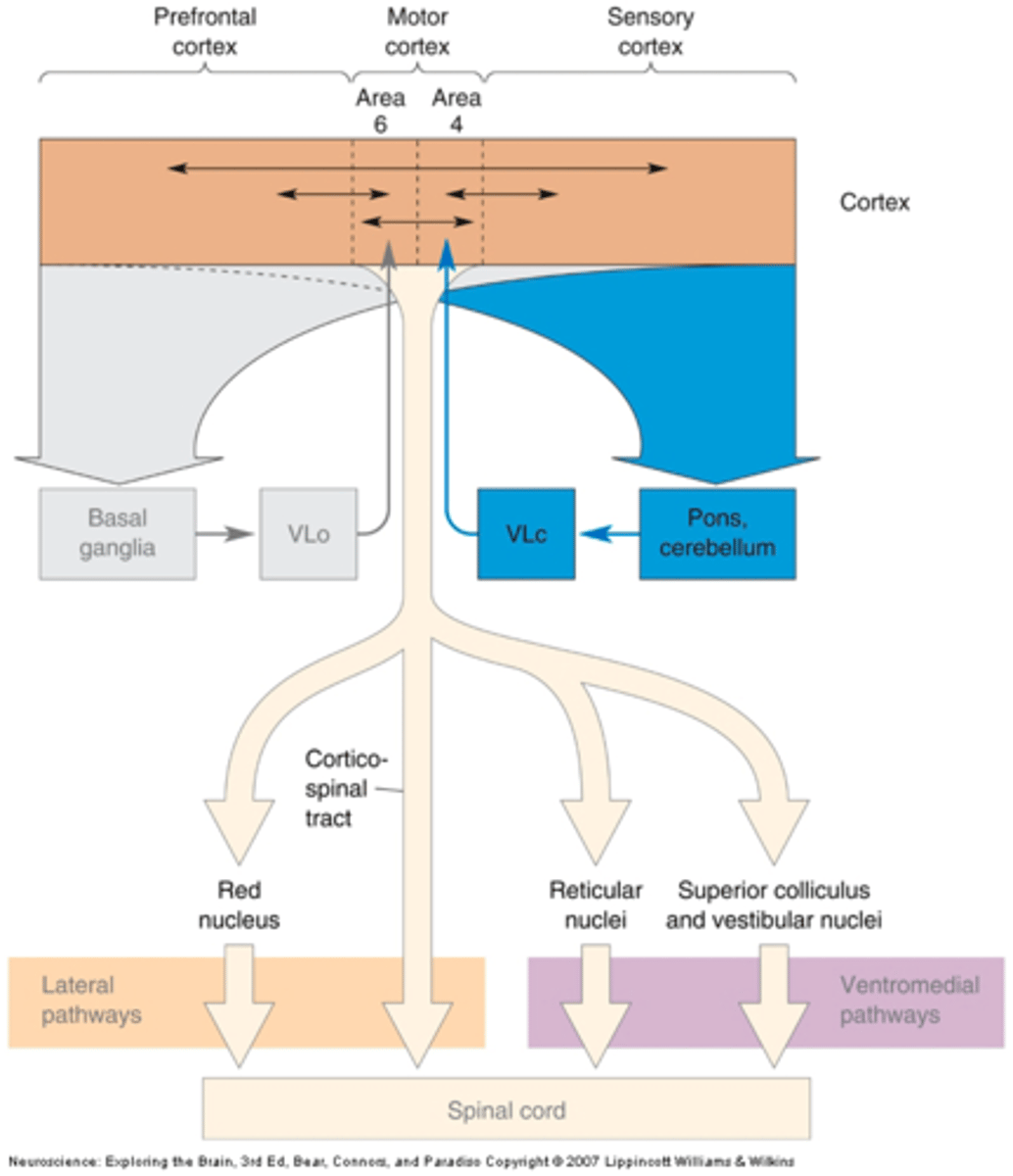
Thalamus
In turn the cerebellum projects back to the motor cortex via the ______________ (VLc) but it has no direct output to the spinal cord
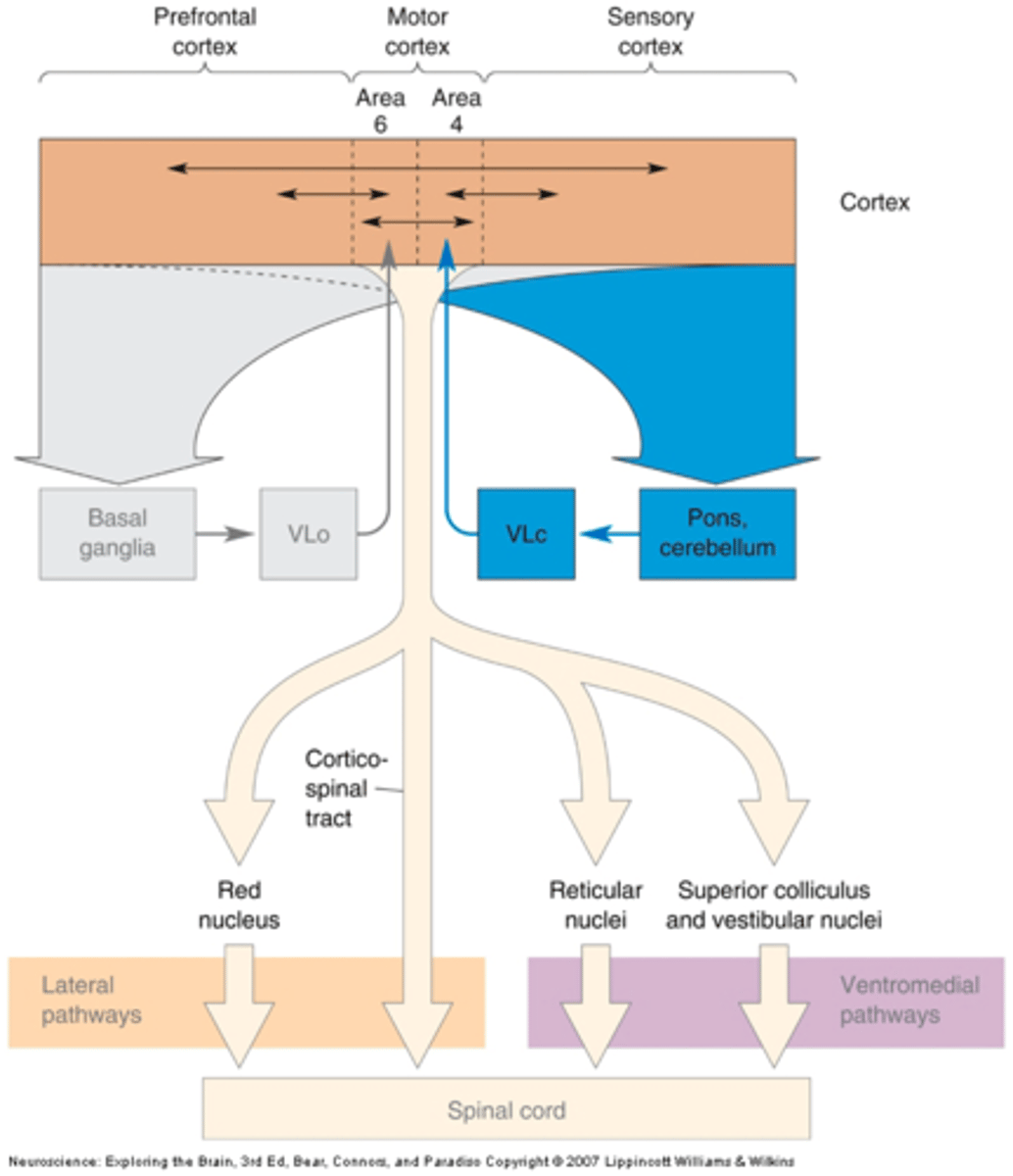
Detect and correct differences between the intended movement and the actual movement - the so-called motor error (it records the motor error detected and build it into its prediction for the next time you make the movement)
What is the primary function of the cerebellum?
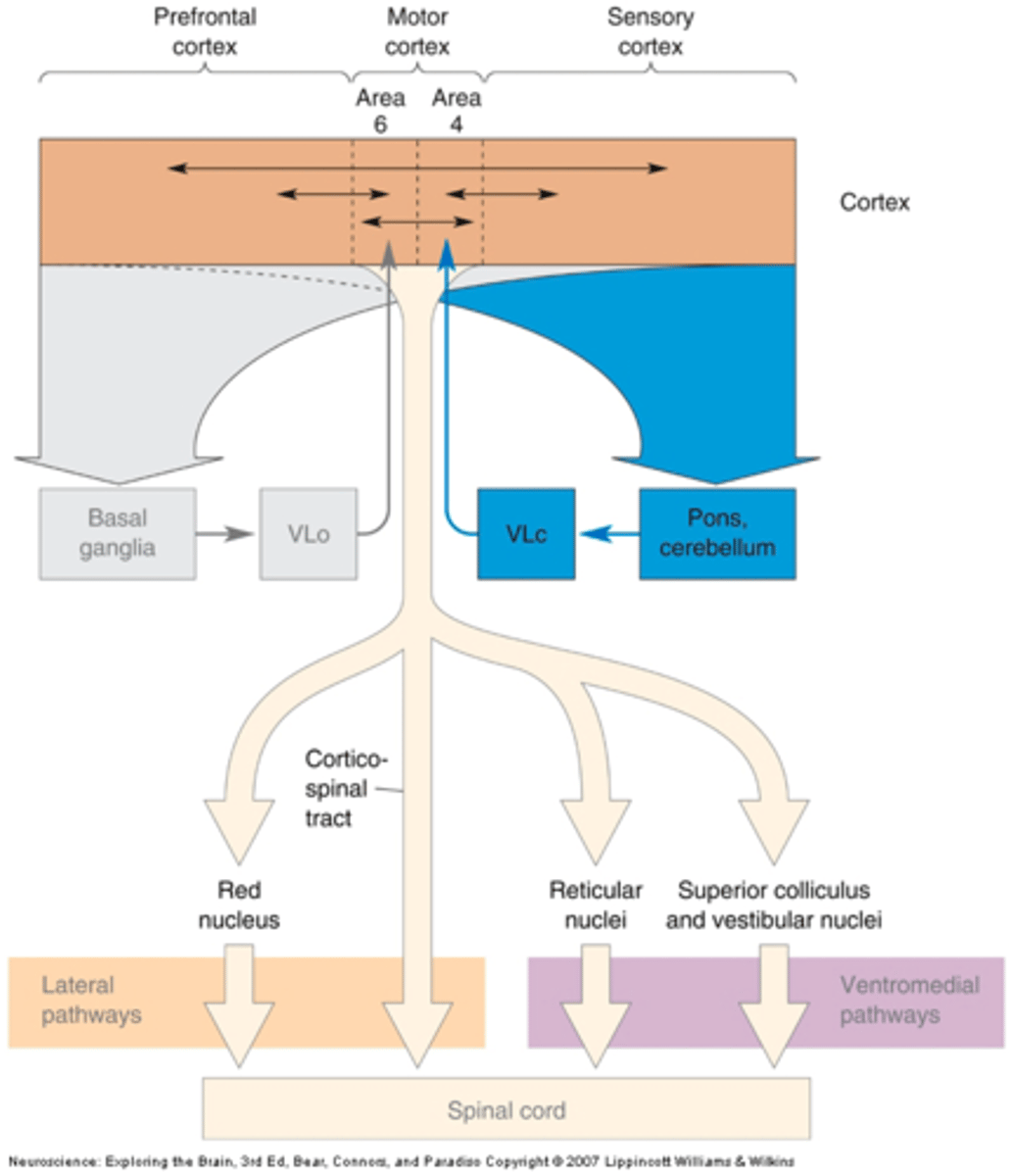
Cerebellar ataxia
Lesions in the cerebellum result in _______________ __________, a condition characterised by poorly integrated movement
Dyssynergia
Even a simple task like touching your nose requires co-ordination of multiple muscles and joints in sequence - In ataxia this ability is lost, what is this called?
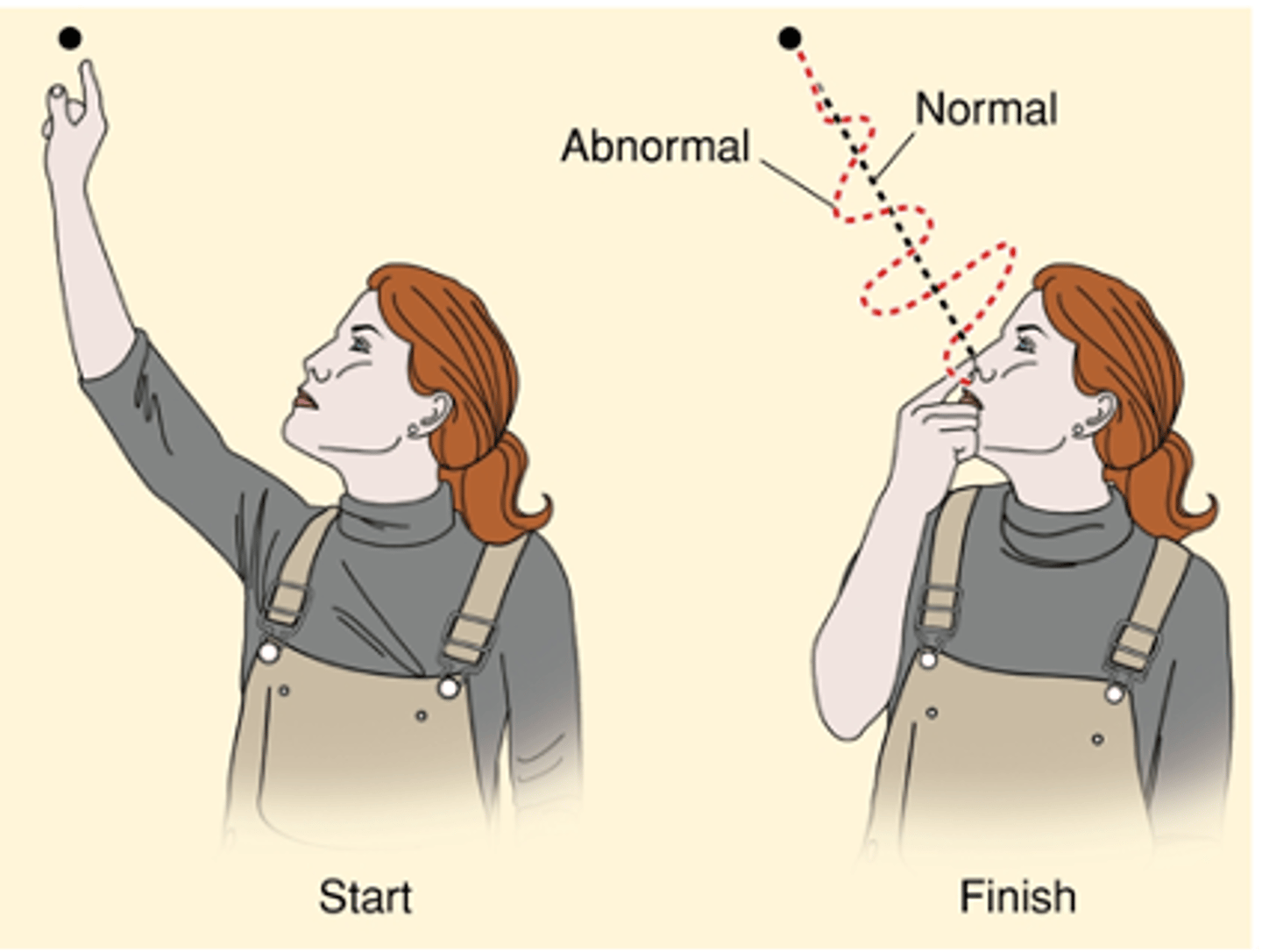
Alcohol intoxication
What has a similar affect to dyssynergia because it depressed cerebellar circuits?
Cerebellar ataxia, neuronal degeneration, Creutzfeld-Jacob Disease
The cerebellum is a major target in BSE (bovine spongiform encephalitis) which is characterised by _____________ _________
BSE is caused by __________ ______________ caused by a self-replicating protein called a prion
In humans this is called ____________-__________ ___________ (CJD)
Spinal motor units
The brain exerts control over ...?
Lower
Spinal motor neurons = _______ motor neurons
In brainstem and cortex
Where do upper motor neurons reside?
Motor neuron
________ _________ disease can affect either upper or lower motor neurons
Movement
Postural control is integrated with ...?
Anticipation
Different regions of the motor cortex initiate ____________
The basal ganglia
What initiates movement?
Neuronal degeneration
Huntington's chorea and Parkinson's disease result when ____________ _______________ affects different parts of the basal ganglia system
Motor actions
What is the cerebellum involved in perfecting?
Lewy bodies (intracellular protein aggregates)
Degeneration of dopaminergic neurons is marked by the presence of what?

The neurons that make it are dying
Dopamine loss here means reduction - DA levels fall over time because of what?